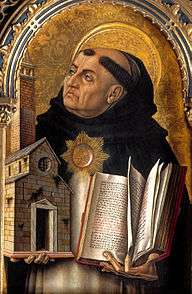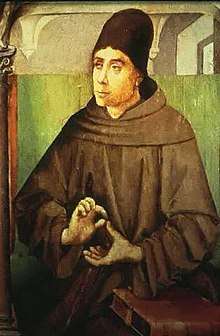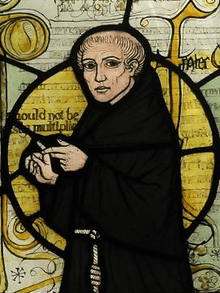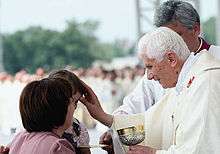Pope Benedict XVI
Pope Benedict XVI (Latin: Benedictus XVI; Italian: Benedetto XVI; German: Benedikt XVI.; born Joseph Aloisius Ratzinger, German: [ˈjoːzɛf ˈalɔʏzi̯ʊs ˈʁatsɪŋɐ], 16 April 1927) is a retired prelate of the Catholic Church who served as head of the Church and sovereign of the Vatican City State from 2005 until his resignation in 2013. Benedict's election as pope occurred in the 2005 papal conclave that followed the death of Pope John Paul II. Benedict chose to be known by the title "pope emeritus" upon his resignation.[10][11]
Pope Benedict XVI | |
|---|---|
| Bishop of Rome | |
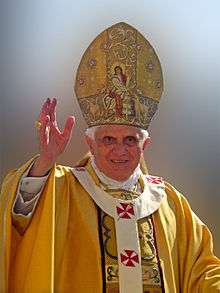 | |
| Papacy began | 19 April 2005 |
| Papacy ended | 28 February 2013 |
| Predecessor | John Paul II |
| Successor | Francis |
| Orders | |
| Ordination | 29 June 1951 by Michael von Faulhaber |
| Consecration | 28 May 1977 by Josef Stangl |
| Created cardinal | 27 June 1977 by Paul VI |
| Personal details | |
| Birth name | Joseph Aloisius Ratzinger |
| Born | 16 April 1927 Marktl, German Reich |
| Nationality | German |
| Residence | Mater Ecclesiae Monastery, Vatican City |
| Parents | Joseph Ratzinger Sr. Maria Peintner |
| Previous post |
|
| Motto | Cooperatores veritatis ('Cooperators of the truth')[1] |
| Signature | |
| Coat of arms | 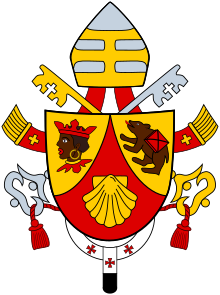 |
| Other popes named Benedict | |
Joseph Ratzinger | |
|---|---|
| Born | Joseph Aloisius Ratzinger |
Notable work | Jesus of Nazareth Introduction to Christianity Death and Eternal Life Deus caritas est |
| Era | Contemporary philosophy |
| Region | Western Philosophy |
| School | Platonism[2] Augustinism |
Main interests | Christian theology, ecclesiology, piano |
Notable ideas | Dehellenization |
Influences
| |
| Papal styles of Pope Benedict XVI | |
|---|---|
 | |
| Reference style | His Holiness |
| Spoken style | Your Holiness |
| Religious style | Pope Emeritus[10][11] |
Ordained as a priest in 1951 in his native Bavaria, Ratzinger embarked on an academic career and established himself as a highly regarded theologian by the late 1950s. He was appointed a full professor in 1958 at the age 31. After a long career as a professor of theology at several German universities, he was appointed Archbishop of Munich and Freising and Cardinal by Pope Paul VI in 1977, an unusual promotion for someone with little pastoral experience. In 1981, he was appointed Prefect of the Congregation for the Doctrine of the Faith, one of the most important dicasteries of the Roman Curia. From 2002 until his election as pope, he was also Dean of the College of Cardinals. Prior to becoming pope, he was "a major figure on the Vatican stage for a quarter of a century"; he had an influence "second to none when it came to setting church priorities and directions" as one of John Paul II's closest confidants.[12] He has lived in Rome since 1981.
His prolific writings[13] generally defend traditional Catholic doctrine and values. He was originally a liberal theologian, but adopted conservative views after 1968.[14] During his papacy, Benedict XVI advocated a return to fundamental Christian values to counter the increased secularisation of many Western countries. He views relativism's denial of objective truth, and the denial of moral truths in particular, as the central problem of the 21st century. He taught the importance of both the Catholic Church and an understanding of God's redemptive love.[15] Pope Benedict also revived a number of traditions, including elevating the Tridentine Mass to a more prominent position.[16] He strengthened the relationship between the Catholic Church and art, promoted the use of Latin,[17] and reintroduced traditional papal garments, for which reason he was called "the pope of aesthetics".[18] He has been described as "the main intellectual force in the Church" since the mid-1980s.[19]
On 11 February 2013, Benedict unexpectedly announced his resignation in a speech in Latin before the cardinals, citing a "lack of strength of mind and body" due to his advanced age. His resignation became effective on 28 February 2013. He is the first pope to resign since Gregory XII in 1415, and the first to do so on his own initiative since Celestine V in 1294. As pope emeritus, Benedict retains the style of His Holiness and continues to dress in the papal colour of white. He was succeeded by Pope Francis on 13 March 2013, and he moved into the newly renovated Mater Ecclesiae Monastery for his retirement on 2 May 2013. In his retirement, Benedict XVI has made occasional public appearances alongside Francis.
In addition to his native German, Benedict speaks French, Italian and English[20] fluently. He also has an excellent command of Latin[21] and speaks Spanish adequately. Furthermore, he has much knowledge of Portuguese. He can read Ancient Greek and biblical Hebrew.[22] He has stated that his first foreign language is French. He is a member of several scientific academies, such as the French Académie des Sciences Morales et Politiques. He plays the piano and has a preference for Mozart and Bach.[23]
Early life: 1927–1951
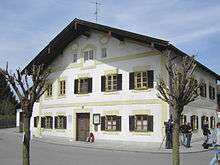
Joseph Aloisius Ratzinger was born on 16 April, Holy Saturday, 1927, at Schulstraße 11, at 8:30 in the morning in his parents' home in Marktl, Bavaria, Germany. He was baptised the same day. He is the third and youngest child of Joseph Ratzinger Sr., a police officer, and Maria Ratzinger (née Peintner); his grand-uncle was the German priest-politician Georg Ratzinger. His mother's family was originally from South Tyrol (now in Italy).[24] Pope Benedict's elder brother, Georg Ratzinger, was a Catholic priest and was the former director of the Regensburger Domspatzen choir. His sister, Maria Ratzinger, who never married, managed Cardinal Ratzinger's household until her death in 1991.
At the age of five, Ratzinger was in a group of children who welcomed the visiting Cardinal Archbishop of Munich, Michael von Faulhaber, with flowers. Struck by the cardinal's distinctive garb, he announced later that day that he wanted to be a cardinal. He attended the elementary school in Aschau am Inn, which was renamed in his honour in 2009.[25]
Ratzinger's family, especially his father, bitterly resented the Nazis, and his father's opposition to Nazism resulted in demotions and harassment of the family.[26] Following his 14th birthday in 1941, Ratzinger was conscripted into the Hitler Youth—as membership was required by law for all 14-year-old German boys after March 1939[27]—but was an unenthusiastic member who refused to attend meetings, according to his brother.[28] In 1941, one of Ratzinger's cousins, a 14-year-old boy with Down syndrome, was taken away by the Nazi regime and murdered during the Action T4 campaign of Nazi eugenics.[29] In 1943, while still in seminary, he was drafted into the German anti-aircraft corps as Luftwaffenhelfer.[28] Ratzinger then trained in the German infantry.[30] As the Allied front drew closer to his post in 1945, he deserted back to his family's home in Traunstein after his unit had ceased to exist, just as American troops established a headquarters in the Ratzinger household.[31] As a German soldier, he was interned in a prisoner of war camp, but released a few months later at the end of the war in May 1945.[31]
Ratzinger and his brother Georg entered Saint Michael Seminary in Traunstein in November 1945, later studying at the Ducal Georgianum (Herzogliches Georgianum) of the Ludwig-Maximilian University in Munich. They were both ordained in Freising on 29 June 1951 by Cardinal Michael von Faulhaber of Munich. Ratzinger recalled: "at the moment the elderly Archbishop laid his hands on me, a little bird – perhaps a lark – flew up from the altar in the high cathedral and trilled a little joyful song."[32]
Ratzinger's 1953 dissertation was on St. Augustine and was titled The People and the House of God in Augustine's Doctrine of the Church. His habilitation (which qualified him for a professorship) was on Bonaventure. It was completed in 1957 and he became a professor of Freising College in 1958.
Encounter with Romano Guardini
In his early twenties, he was deeply influenced by the thought of Italian German Romano Guardini[33] who taught in Munich 1946 to 1951 when Ratzinger was studying in Freising and later at the University of Munich. The intellectual affinity between these two thinkers, who would later become decisive figures for the twentieth-century Church, was preoccupied with rediscovering the essential in Christianity: Guardini wrote his 1938 "The Essence of Christianity," while Ratzinger penned "Introduction to Christianity," three decades later in 1968. Guardini inspired many in the Catholic social-democratic tradition, particularly the Communion and Liberation movement in the New Evangelization encouraged under the papacy of Polish Pope John Paul II. Ratzinger wrote an introduction to a 1996 reissue of Guardini's 1954 "The Lord".[34]
Pre-papal career
Ordination history of Pope Benedict XVI | |||||||||||||||||||||||||||||||||||||||||||||||||||||||||
|---|---|---|---|---|---|---|---|---|---|---|---|---|---|---|---|---|---|---|---|---|---|---|---|---|---|---|---|---|---|---|---|---|---|---|---|---|---|---|---|---|---|---|---|---|---|---|---|---|---|---|---|---|---|---|---|---|---|
| |||||||||||||||||||||||||||||||||||||||||||||||||||||||||
| |||||||||||||||||||||||||||||||||||||||||||||||||||||||||
Academic career: 1951–1977
| Part of a series on the |
| Theology of Pope Benedict XVI |
|---|
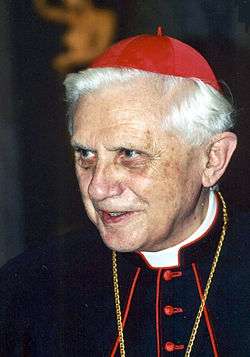 |
|
Movements
|
|
Ratzinger became a professor at the University of Bonn in 1959, with his inaugural lecture on "The God of Faith and the God of Philosophy". In 1963, he moved to the University of Münster. During this period, he participated in the Second Vatican Council (1962–1965) and served as a peritus (theological consultant) to Cardinal Frings of Cologne. He was viewed during the time of the council as a reformer, cooperating with theologians like Hans Küng and Edward Schillebeeckx. Ratzinger became an admirer of Karl Rahner, a well-known academic theologian of the Nouvelle Théologie and a proponent of church reform.
In 1966, Ratzinger was appointed to a chair in dogmatic theology at the University of Tübingen, where he was a colleague of Hans Küng. In his 1968 book Introduction to Christianity, he wrote that the pope has a duty to hear differing voices within the Church before making a decision, and he downplayed the centrality of the papacy. During this time, he distanced himself from the atmosphere of Tübingen and the Marxist leanings of the student movement of the 1960s that quickly radicalised, in the years 1967 and 1968, culminating in a series of disturbances and riots in April and May 1968. Ratzinger came increasingly to see these and associated developments (such as decreasing respect for authority among his students) as connected to a departure from traditional Catholic teachings.[35] Despite his reformist bent, his views increasingly came to contrast with the liberal ideas gaining currency in theological circles.[36]
Some voices, among them Küng, deem this a turn towards conservatism, while Ratzinger himself said in a 1993 interview, "I see no break in my views as a theologian [over the years]".[37] Ratzinger continued to defend the work of the Second Vatican Council, including Nostra aetate, the document on respect of other religions, ecumenism and the declaration of the right to freedom of religion. Later, as the Prefect of the Congregation for the Doctrine of the Faith, Ratzinger most clearly spelled out the Catholic Church's position on other religions in the 2000 document Dominus Iesus which also talks about the Catholic way to engage in "ecumenical dialogue". During his time at Tübingen University, Ratzinger published articles in the reformist theological journal Concilium, though he increasingly chose less reformist themes than other contributors to the magazine such as Küng and Schillebeeckx.
In 1969, he returned to Bavaria, to the University of Regensburg and co-founded the theological journal Communio, with Hans Urs von Balthasar, Henri de Lubac, Walter Kasper and others, in 1972. Communio, now published in seventeen languages, including German, English and Spanish, has become a prominent journal of contemporary Catholic theological thought. Until his election as pope, he remained one of the journal's most prolific contributors. In 1976, he suggested that the Augsburg Confession might possibly be recognised as a Catholic statement of faith.[38][39] Several of Benedict's former students became his confidantes, notably Christoph Schönborn, and a number of his former students sometimes meet for discussions.[40][41] He served as Vice President of the University of Regensburg from 1976 to 1977.[42]
Archbishop of Munich and Freising: 1977–1982
On 24 March 1977, Ratzinger was appointed Archbishop of Munich and Freising. He took as his episcopal motto Cooperatores Veritatis (Co-workers of the Truth) from 3 John 8, a choice he comments upon in his autobiographical work, Milestones. In the consistory of the following 27 June, he was named Cardinal-Priest of Santa Maria Consolatrice al Tiburtino by Pope Paul VI. By the time of the 2005 Conclave, he was one of only 14 remaining cardinals appointed by Paul VI, and one of only three of those under the age of 80. Of these, only he and William Wakefield Baum took part in the conclave.[43]
Prefect of the Sacred Congregation for the Doctrine of the Faith: 1981–2005
On 25 November 1981, Pope John Paul II, upon the retirement of Franjo Šeper, named Ratzinger as the Prefect of the Sacred Congregation for the Doctrine of the Faith, formerly known as the "Sacred Congregation of the Holy Office", the historical Roman Inquisition. Consequently, he resigned his post at Munich in early 1982. He was promoted within the College of Cardinals to become Cardinal Bishop of Velletri-Segni in 1993 and was made the college's vice-dean in 1998 and dean in 2002. Just a year after its foundation in 1990 Joseph Cardinal Ratzinger joined the European Academy of Sciences and Arts in Salzburg/Austria in 1991.[44][45]
Ratzinger defended and reaffirmed Catholic doctrine, including teaching on topics such as birth control, homosexuality and inter-religious dialogue. The theologian Leonardo Boff, for example, was suspended, while others such as Matthew Fox were censured. Other issues also prompted condemnations or revocations of rights to teach: for instance, some posthumous writings of Jesuit priest Anthony de Mello were the subject of a notification. Ratzinger and the congregation viewed many of them, particularly the later works, as having an element of religious indifferentism (i.e., Christ was "one master alongside others"). In particular, Dominus Iesus, published by the congregation in the jubilee year 2000, reaffirmed many recently "unpopular" ideas, including the Catholic Church's position that "Salvation is found in no one else, for there is no other name under heaven given to men by which we must be saved." The document angered many Protestant churches by claiming that they are not actually churches, but "ecclesial communities".[46]
Ratzinger's 2001 letter De delictis gravioribus clarified the confidentiality of internal church investigations, as defined in the 1962 document Crimen Sollicitationis, into accusations made against priests of certain crimes, including sexual abuse. This became a subject of controversy during the sex abuse cases.[47] For 20 years, Ratzinger had been the man in charge of enforcing the document.[48]
While bishops hold the secrecy pertained only internally, and did not preclude investigation by civil law enforcement, the letter was often seen as promoting a coverup.[49] Later, as pope, he was accused in a lawsuit of conspiring to cover up the molestation of three boys in Texas, but sought and obtained diplomatic immunity from liability.[50]
On 12 March 1983, Ratzinger, as prefect, notified the lay faithful and the clergy that Archbishop Pierre Martin Ngo Dinh Thuc had incurred excommunication latae sententiae for illicit episcopal consecrations without the apostolic mandate. In 1997, when he turned 70, Ratzinger asked Pope John Paul II for permission to leave the Congregation of the Doctrine of Faith and to become an archivist in the Vatican Secret Archives and a librarian in the Vatican Library, but Pope John Paul ll refused his assent.[51][52]
Papacy: 2005–2013
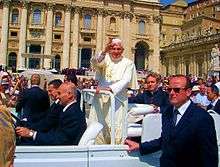
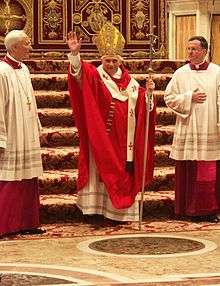
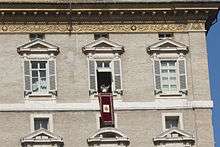
Election to the papacy
Benedict XVI was elected the 265th pope at the age of 78. He is the oldest person to have been elected pope since Pope Clement XII (1730–1740). He served longer as a cardinal before becoming Pope than any Pontiff since Benedict XIII (1724–1730). Benedict and his Polish predecessor John Paul II were the first consecutive non-Italian popes since the seven consecutive Frenchmen of the Avignon Papacy (1309–1378). The last pope named Benedict was Benedict XV, an Italian who reigned from 1914 to 1922, during World War I (1914–1918).
On 2 January 2005, Time magazine quoted unnamed Vatican sources as saying that Ratzinger was a front runner to succeed John Paul II should he die or become too ill to continue as pope. On the death of John Paul II, the Financial Times gave the odds of Ratzinger becoming pope as 7–1, the lead position, but close to his rivals on the liberal wing of the church. In April 2005, before his election as pope, he was identified as one of the 100 most influential people in the world by Time.[53] While Prefect of the Congregation for the Doctrine of the Faith, Ratzinger repeatedly stated he would like to retire to his house in the Bavarian village of Pentling near Regensburg and dedicate himself to writing books.
At the conclave, "it was, if not Ratzinger, who? And as they came to know him, the question became, why not Ratzinger?"[54][55] On 19 April 2005, he was elected on the second day after four ballots.[54] Cardinal Cormac Murphy-O'Connor described the final vote, "It's very solemn when you go up one by one to put your vote in the urn and you're looking up at the Last Judgement of Michelangelo. And I still remember vividly the then Cardinal Ratzinger sitting on the edge of his chair."[56] Ratzinger had hoped to retire peacefully and said that "At a certain point, I prayed to God 'please don't do this to me'...Evidently, this time He didn't listen to me."[57] Before his first appearance on the balcony of Saint Peter's Basilica, he was announced by Jorge Medina Estévez, Cardinal Protodeacon of the Catholic Church. Cardinal Medina Estévez first addressed the massive crowd as "dear(est) brothers and sisters" in Italian, Spanish, French, German and English, with each language receiving cheers from the international crowd, before continuing with the traditional Habemus Papam announcement in Latin.
At the balcony, Benedict's first words to the crowd, given in Italian before he gave the traditional Urbi et Orbi blessing in Latin, were:
Dear brothers and sisters, after the great Pope John Paul II, the Cardinals have elected me, a simple, humble labourer in the vineyard of the Lord. The fact that the Lord knows how to work and to act even with insufficient instruments comforts me, and above all I entrust myself to your prayers. In the joy of the Risen Lord, confident of his unfailing help, let us move forward. The Lord will help us, and Mary, His Most Holy Mother, will be on our side. Thank you.[58]
On 24 April, he celebrated the Papal Inauguration Mass in St. Peter's Square, during which he was invested with the Pallium and the Ring of the Fisherman. On 7 May, he took possession of his cathedral church, the Archbasilica of St. John Lateran.
Choice of name
Ratzinger chose the pontifical name Benedict, which comes from the Latin word meaning "the blessed", in honour of both Pope Benedict XV and Saint Benedict of Nursia. Pope Benedict XV was pope during the First World War, during which time he passionately pursued peace between the warring nations. St. Benedict of Nursia was the founder of the Benedictine monasteries (most monasteries of the Middle Ages were of the Benedictine order) and the author of the Rule of Saint Benedict, which is still the most influential writing regarding the monastic life of Western Christianity. The Pope explained his choice of name during his first general audience in St. Peter's Square, on 27 April 2005:
Filled with sentiments of awe and thanksgiving, I wish to speak of why I chose the name Benedict. Firstly, I remember Pope Benedict XV, that courageous prophet of peace, who guided the Church through turbulent times of war. In his footsteps I place my ministry in the service of reconciliation and harmony between peoples. Additionally, I recall Saint Benedict of Nursia, co-patron of Europe, whose life evokes the Christian roots of Europe. I ask him to help us all to hold firm to the centrality of Christ in our Christian life: May Christ always take first place in our thoughts and actions![59]
Tone of papacy
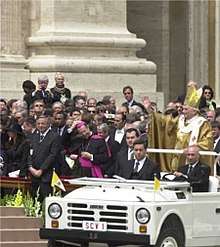
During his inaugural Mass, the previous custom of every cardinal submitting to the Pope was replaced by having twelve people, including cardinals, clergy, religious, a married couple and their child, and newly confirmed people, greet him. (The cardinals had formally sworn their obedience upon his election.) He began using an open-topped papal car, saying that he wanted to be closer to the people. Pope Benedict continued the tradition of his predecessor John Paul II and baptised several infants in the Sistine Chapel at the beginning of each year, on the Feast of the Baptism of the Lord, in his pastoral role as Bishop of Rome.
Beatifications
On 9 May 2005, Benedict XVI began the beatification process for his predecessor, Pope John Paul II. Normally, five years must pass after a person's death before the beatification process can begin. However, in an audience with Pope Benedict, Camillo Ruini, Vicar General of the Diocese of Rome and the official responsible for promoting the cause for canonization of any person who dies within that diocese, cited "exceptional circumstances" which suggested that the waiting period could be waived. This happened before, when Pope Paul VI waived the five-year rule and announced beatification processes for two of his predecessors, Pope Pius XII and Pope John XXIII. Benedict XVI followed this precedent when he waived the five-year rule for John Paul II.[60] The decision was announced on 13 May 2005, the Feast of Our Lady of Fátima and the 24th anniversary of the attempt on John Paul II's life.[61] John Paul II often credited Our Lady of Fátima for preserving him on that day. Cardinal Ruini inaugurated the diocesan phase of the cause for beatification in the Lateran Basilica on 28 June 2005.[62]
The first beatification under the new pope was celebrated on 14 May 2005, by José Cardinal Saraiva Martins, Cardinal Prefect of the Congregation for the Causes of Saints. The new Blesseds were Mother Marianne Cope and Mother Ascensión Nicol Goñi. Cardinal Clemens August Graf von Galen was beatified on 9 October 2005. Mariano de la Mata was beatified in November 2006 and Rosa Eluvathingal was beatified 3 December of that year, and Fr. Basil Moreau was beatified September 2007.[63] In October 2008, the following beatifications took place: Celestine of the Mother of God, Giuseppina Nicoli, Hendrina Stenmanns, Maria Rosa Flesch, Marta Anna Wiecka, Michael Sopocko, Petrus Kibe Kasui and 187 Companions, Susana Paz-Castillo Ramírez, and Maria Isbael Salvat Romero.
On 19 September 2010, during his visit to the United Kingdom, Benedict personally proclaimed the beatification of John Henry Newman.[64]
Unlike his predecessor, Benedict XVI delegated the beatification liturgical service to a Cardinal. On 29 September 2005, the Congregation for the Causes of Saints issued a communiqué announcing that henceforth beatifications would be celebrated by a representative of the pope, usually the prefect of that Congregation.[65]
Canonizations
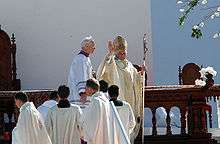
Pope Benedict XVI celebrated his first canonizations on 23 October 2005 in St. Peter's Square when he canonized Josef Bilczewski, Alberto Hurtado SJ, Zygmunt Gorazdowski, Gaetano Catanoso and Felice da Nicosia. The canonizations were part of a Mass that marked the conclusion of the General Assembly of the Synod of Bishops and the Year of the Eucharist.[66] Pope Benedict XVI canonized Bishop Rafael Guizar y Valencia, Mother Theodore Guerin, Filippo Smaldone and Rosa Venerini on 15 October 2006.
During his visit to Brazil in 2007, Pope Benedict XVI presided over the canonization of Frei Galvão on 11 May, while George Preca, founder of the Malta-based M.U.S.E.U.M., Szymon of Lipnica, Charles of Mount Argus and Marie-Eugénie de Jésus were canonized in a ceremony held at the Vatican on 3 June 2007.[67] Preca is the first Maltese saint since the country's conversion to Christianity in 60 A.D. when St. Paul converted the inhabitants.[68] In October 2008, the following canonizations took place: Saint Alphonsa of India,[69] Gaetano Errico, Narcisa de Jesus Martillo Moran and Maria Bernarda Bütler. In April 2009, he canonized Arcangelo Tadini, Bernardo Tolomei, Nuno Álvares Pereira, Geltrude Comensoli, and Caterina Volpicelli.[70] In October of the same year he canonized Jeanne Jugan, Jozef Damian de Veuster, Zygmunt Szczęsny Feliński, Francisco Coll Guitart and Rafael Arnáiz Barón.[71][72]
On 17 October 2010, Pope Benedict canonized André Bessette, a French-Canadian; Stanislaw Soltys, a 15th-century Polish priest; Italian nuns Giulia Salzano and Camilla Battista da Varano; Spanish nun Candida Maria de Jesus Cipitria y Barriola and the first Australian saint, Mother Mary MacKillop.[73] On 23 October 2011, Pope Benedict XVI canonized three saints: a Spanish nun Bonifacia Rodríguez y Castro, Italian archbishop Guido Maria Conforti and Italian priest Luigi Guanella.[74] In December 2011, Pope Benedict formally recognized the validity of the miracles necessary to proceed with the canonizations of Kateri Tekakwitha, who would be the first Native American saint, Marianne Cope, a nun working with lepers in what is now the state of Hawaii, Giovanni Battista Piamarta, an Italian priest, Jacques Berthieu, a French Jesuit priest and African martyr, Carmen Salles y Barangueras, a Spanish nun and founder of the Sisters of the Immaculate Conception, Peter Calungsod, a lay catechist and martyr from the Philippines, and Anna Schäffer, whose desire to be a missionary was unfulfilled on account of her illness.[75] They were canonized on 21 October 2012.[76]
Doctors of the Church
On 7 October 2012, Pope Benedict XVI named Hildegard of Bingen and John of Avila Doctors of the Church, the 34th and 35th individuals so recognised in the history of Christianity.[77]
Curia reform
Pope Benedict made only modest changes to the structure of the Roman Curia. In March 2006, he placed both the Pontifical Council for Pastoral Care of Migrants and Itinerant Peoples and the Pontifical Council for Justice and Peace under a single president, Cardinal Renato Martino. When Martino retired in 2009, the Councils each received its own preside once again. Also in March 2006, the Pontifical Council for Interreligious Dialogue was briefly merged into the Pontifical Council for Culture under Cardinal Paul Poupard. Those Councils maintained their separate officials and staffs while their status and competencies continued unchanged, and in May 2007, Interreligious Dialogue was restored to its separate status again with its own president.[78] In June 2010, Benedict created the Pontifical Council for the Promotion of the New Evangelisation, appointing Archbishop Rino Fisichella its first president.[79] On 16 January 2013, Pope Benedict transferred responsibility for catechesis from the Congregation for the Clergy to the Pontifical Council for Promoting the New Evangelization.[80]
Teachings
As pope, one of Benedict XVI's main roles was to teach about the Catholic faith and the solutions to the problems of discerning and living the faith,[81] a role that he could play well as a former head of the Church's Congregation for the Doctrine of the Faith. The main points of emphasis of his teachings are stated in more detail in Theology of Pope Benedict XVI.
"Friendship with Jesus Christ"
At the conclusion of his first homily as pope, Benedict referred to both Jesus Christ and John Paul II. Citing John Paul II's well-known words, "Do not be afraid! Open wide the doors for Christ!", Benedict XVI said:
Are we not perhaps all afraid in some way? If we let Christ enter fully into our lives, if we open ourselves totally to Him, are we not afraid that He might take something away from us?...And once again the Pope said: No! If we let Christ into our lives, we lose nothing, nothing, absolutely nothing of what makes life free, beautiful and great. No! Only in this friendship do we experience beauty and liberation....When we give ourselves to Him, we receive a hundredfold in return. Yes, open, open wide the doors to Christ – and you will find true life.[82]
"Friendship with Jesus Christ" is a frequent theme of his preaching.[83][84] He stressed that on this intimate friendship, "everything depends."[85] He also said: "We are all called to open ourselves to this friendship with God... speaking to him as to a friend, the only One who can make the world both good and happy... That is all we have to do is put ourselves at his disposal...is an extremely important message. It is a message that helps to overcome what can be considered the great temptation of our time: the claim, that after the Big Bang, God withdrew from history."[86] Thus, in his book Jesus of Nazareth, his main purpose was "to help foster [in the reader] the growth of a living relationship" with Jesus Christ.[85]
He took up this theme in his first encyclical Deus caritas est. In his personal explanation and summary of the encyclical, he stated: "If friendship with God becomes for us something ever more important and decisive, then we will begin to love those whom God loves and who are in need of us. God wants us to be friends of his friends and we can be so, if we are interiorly close to them."[87] Thus, he said that prayer is "urgently needed... It is time to reaffirm the importance of prayer in the face of the activism and the growing secularism of many Christians engaged in charitable work."
"Dictatorship of relativism"
Continuing what he said in the pre-conclave Mass about what he often referred to as the "central problem of our faith today",[88] on 6 June 2005 Pope Benedict also said:
Today, a particularly insidious obstacle to the task of education is the massive presence in our society and culture of that relativism which, recognising nothing as definitive, leaves as the ultimate criterion only the self with its desires. And under the semblance of freedom it becomes a prison for each one, for it separates people from one another, locking each person into his or her own ego.[89]
He said that "a dictatorship of relativism"[90] was the core challenge facing the church and humanity. At the root of this problem, he said, is Kant's "self-limitation of reason". This, he said, is contradictory to the modern acclamation of science whose excellence is based on the power of reason to know the truth. He said that this self-amputation of reason leads to pathologies of religion such as terrorism and pathologies of science such as ecological disasters.[91] Benedict traced the failed revolutions and violent ideologies of the 20th century to a conversion of partial points of view into absolute guides. He said "Absolutizing what is not absolute but relative is called totalitarianism."[92]
In an address to a conference of the Diocese of Rome held at the basilica of St. John Lateran 6 June 2005, Benedict remarked on the issues of same sex marriage and abortion:
The various forms of the dissolution of matrimony today, like free unions, trial marriages and going up to pseudo-matrimonies by people of the same sex, are rather expressions of an anarchic freedom that wrongly passes for true freedom of man...from here it becomes all the more clear how contrary it is to human love, to the profound vocation of man and woman, to systematically close their union to the gift of life, and even worse to suppress or tamper with the life that is born.[93]
Christianity as religion according to reason
In the discussion with secularism and rationalism, one of Benedict's basic ideas can be found in his address on the "Crisis of Culture" in the West, a day before Pope John Paul II died, when he referred to Christianity as the Religion of the Logos (the Greek for "word", "reason", "meaning", or "intelligence"). He said:
From the beginning, Christianity has understood itself as the religion of the Logos, as the religion according to reason... It has always defined men, all men without distinction, as creatures and images of God, proclaiming for them...the same dignity. In this connection, the Enlightenment is of Christian origin and it is no accident that it was born precisely and exclusively in the realm of the Christian faith....It was and is the merit of the Enlightenment to have again proposed these original values of Christianity and of having given back to reason its own voice... Today, this should be precisely [Christianity's] philosophical strength, in so far as the problem is whether the world comes from the irrational, and reason is not other than a 'sub-product,' on occasion even harmful of its development—or whether the world comes from reason, and is, as a consequence, its criterion and goal...In the so necessary dialogue between secularists and Catholics, we Christians must be very careful to remain faithful to this fundamental line: to live a faith that comes from the Logos, from creative reason, and that, because of this, is also open to all that is truly rational.[94]
Benedict also emphasised that "Only creative reason, which in the crucified God is manifested as love, can really show us the way."[94]
Encyclicals
Pope Benedict wrote three encyclicals: Deus caritas est (Latin for "God is Love"), Spe Salvi ("Saved by Hope"), and Caritas in veritate ("Love in Truth"). In his first encyclical, Deus caritas est, he said that a human being, created in the image of God who is love, is able to practice love: to give himself to God and others (agape) by receiving and experiencing God's love in contemplation. This life of love, according to him, is the life of the saints such as Teresa of Calcutta and the Blessed Virgin Mary, and is the direction Christians take when they believe that God loves them in Jesus Christ.[95]
The encyclical contains almost 16,000 words in 42 paragraphs. The first half is said to have been written by Benedict in German, his first language, in the summer of 2005; the second half is derived from uncompleted writings left by his predecessor, Pope John Paul II.[96] The document was signed by Pope Benedict on Christmas Day, 25 December 2005.[97] The encyclical was promulgated a month later in Latin and was translated into English, French, German, Italian, Polish, Portuguese and Spanish. It is the first encyclical to be published since the Vatican decided to assert copyright in the official writings of the pope.[98]
Benedict's second encyclical titled Spe Salvi ("Saved by Hope"), about the virtue of hope, was released on 30 November 2007.[99][100] His third encyclical titled Caritas in veritate ("Love in Truth" or "Charity in Truth"), was signed on 29 June 2009 (the Feast of Sts. Peter and Paul) and released on 7 July 2009.[101] In it, the Pope continued the Church's teachings on social justice. He condemned the prevalent economic system "where the pernicious effects of sin are evident," and called on people to rediscover ethics in business and economic relations.[101]
At the time of his resignation, Benedict had completed a draft of a fourth encyclical entitled Lumen fidei ("The Light of Faith"),[102] intended to accompany his first two encyclicals to complete a trilogy on the three theological virtues of faith, hope, and love. Benedict's successor, Pope Francis, completed and published Lumen Fidei in June 2013, four months after Benedict's retirement and Francis' succession. Although the encyclical is officially the work of Pope Francis, paragraph 7 of the encyclical explicitly expresses Francis' debt to Benedict: "These considerations on faith — in continuity with all that the Church's magisterium has pronounced on this theological virtue — are meant to supplement what Benedict XVI had written in his encyclical letters on charity and hope. He himself had almost completed a first draft of an encyclical on faith. For this I am deeply grateful to him, and as his brother in Christ I have taken up his fine work and added a few contributions of my own."[103]
Post-synodal apostolic exhortation
Sacramentum caritatis (The Sacrament of Charity), signed 22 February 2007, was released in Latin, Italian, English, French, German, Portuguese, Spanish and Polish. It was made available in various languages 13 March 2007 in Rome. The English edition from Libera Editrice Vaticana is 158 pages. This apostolic exhortation "seeks to take up the richness and variety of the reflections and proposals which emerged from the Ordinary General Assembly of the Synod of Bishops" which was held in 2006.[104]
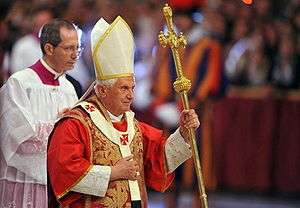
Motu proprio on Tridentine Mass
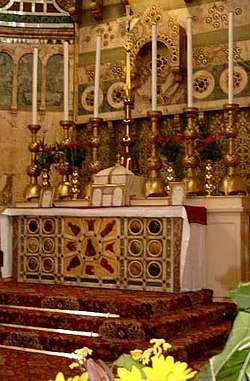
The high altar of a church was usually preceded by three steps, below which were said the Prayers at the Foot of the Altar. Side altars usually had only one step.
On 7 July 2007, Benedict XVI issued the motu proprio Summorum Pontificum, declaring that upon "the request of the faithful", celebration of Mass according to the Missal of 1962 (commonly known as the Tridentine Mass), was to be more easily permitted. Stable groups who previously had to petition their bishop to have a Tridentine Mass may now merely request permission from their local priest.[105] While Summorum Pontificum directs that pastors should provide the Tridentine Mass upon the requests of the faithful, it also allows for any qualified priest to offer private celebrations of the Tridentine Mass, to which the faithful may be admitted if they wish.[106] For regularly scheduled public celebrations of the Tridentine Mass, the permission of the priest in charge of the church is required.[107]
In an accompanying letter, the Pope outlined his position concerning questions about the new guidelines.[106] As there were fears that the move would entail a reversal of the Second Vatican Council,[108] Benedict emphasised that the Tridentine Mass would not detract from the council, and that the Mass of Paul VI would still be the norm and priests were not permitted to refuse to say the Mass in that form. He pointed out that use of Tridentine Mass "was never juridically abrogated and, consequently, in principle, was always permitted."[106] The letter also decried "deformations of the liturgy ... because in many places celebrations were not faithful to the prescriptions of the new Missal" as the Second Vatican Council was wrongly seen "as authorising or even requiring creativity", mentioning his own experience.[106]
The Pope considered that allowing the Tridentine Mass to those who request it was a means to prevent or heal schism, stating that, on occasions in history, "not enough was done by the Church's leaders to maintain or regain reconciliation and unity" and that this "imposes an obligation on us today: to make every effort to enable for all those who truly desire unity to remain in that unity or to attain it anew."[106] Many feel the decree aimed at ending the schism between the Holy See and traditionalist groups such as the Society of Saint Pius X (SSPX). Cardinal Darío Castrillón Hoyos, the president of the Pontifical Commission established for the purpose of facilitating full ecclesial communion of those associated with that Society,[109] stated that the decree "opened the door for their return". Bishop Bernard Fellay, superior general of the SSPX, expressed "deep gratitude to the Sovereign Pontiff for this great spiritual benefit".[105]
Unicity and salvific universality of the Catholic Church
Near the end of June 2007, the Congregation for the Doctrine of the Faith issued a document approved by Benedict XVI "because some contemporary theological interpretations of Vatican II's ecumenical intent had been 'erroneous or ambiguous' and had prompted confusion and doubt."[110] The document has been seen as restating "key sections of a 2000 text the pope wrote when he was prefect of the congregation, Dominus Iesus."[110]
Consumerism
Benedict XVI condemned excessive consumerism, especially among youth. He stated in December 2007 that "[A]dolescents, youths and even children are easy victims of the corruption of love, deceived by unscrupulous adults who, lying to themselves and to them, draw them into the dead-end streets of consumerism."[111] In June 2009, he blamed outsourcing for greater availability of consumer goods which lead to downsizing of social security systems.[112]
Ecumenism and interfaith dialogue
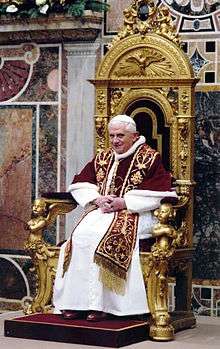
Other Christian denominations
Speaking at his weekly audience in St Peter's Square on 7 June 2006, Pope Benedict asserted that Jesus himself had entrusted the leadership of the Church to his apostle Peter. "Peter's responsibility thus consists of guaranteeing the communion with Christ. Let us pray so that the primacy of Peter, entrusted to poor human beings, may always be exercised in this original sense desired by the Lord, so that it will be increasingly recognised in its true meaning by brothers who are still not in communion with us."
Also in 2006, Benedict met Rowan Williams, Archbishop of Canterbury and spiritual head of the Anglican Communion. In their Common Declaration, they highlighted the previous 40 years of dialogue between Catholics and Anglicans while also acknowledging "serious obstacles to our ecumenical progress".[113] Benedict also acknowledged the Lutheran church, saying that he has had friends in that denomination.
Judaism
When Benedict ascended to the Papacy his election was welcomed by the Anti-Defamation League who noted "his great sensitivity to Jewish history and the Holocaust".[114] However, his election received a more reserved response from the United Kingdom's Chief Rabbi Jonathan Sacks, who hoped that Benedict would "continue along the path of Pope John XXIII and Pope John Paul II in working to enhance relations with the Jewish people and the State of Israel."[115] The Foreign Minister of Israel also offered more tentative praise, though the Minister believed that "this Pope, considering his historical experience, will be especially committed to an uncompromising fight against anti-Semitism."[115]
Critics have accused Benedict's papacy of insensitivity towards Judaism. The two most prominent instances were the expansion of the use of the Tridentine Mass and the lifting of the excommunication on four bishops from the Society of St. Pius X (SSPX). In the Good Friday service, the traditional Mass rubrics include a prayer that asks God to lift the veil so they [Jews] may be delivered from their darkness. This prayer has historically been contentious in Judaic-Catholic relations and several groups saw the restoration of the Tridentine Mass as problematic.[116][117][118][119][120] Among those whose excommunications were lifted was Bishop Richard Williamson, an outspoken historical revisionist sometimes interpreted as a Holocaust denier.[121][122][123][124] The lifting of his excommunication led critics to charge that the Pope was condoning his historical revisionist views.[125]
Islam
Pope Benedict's relations with Islam were strained at times. On 12 September 2006 he delivered a lecture which touched on Islam at the University of Regensburg in Germany. He had served there as a professor of theology before becoming Pope, and his lecture was entitled "Faith, Reason and the University—Memories and Reflections". The lecture received much attention from political and religious authorities. Many Islamic politicians and religious leaders registered their protest against what they labelled an insulting mischaracterisation of Islam, although his focus was aimed towards the rationality of religious violence, and its effect on the religion.[126][127] Muslims were particularly offended by this passage that the Pope quoted in his speech: "Show me just what Muhammad brought that was new and there you will find things only evil and inhuman, such as his command to spread by the sword the faith he preached."[127]
The passage originally appeared in the Dialogue Held with a Certain Persian, the Worthy Mouterizes, in Anakara of Galatia[128][129] written in 1391 as an expression of the views of the Byzantine emperor Manuel II Paleologus, one of the last Christian rulers before the Fall of Constantinople to the Muslim Ottoman Empire, on such issues as forced conversion, holy war, and the relationship between faith and reason. According to the German text, the Pope's original comment was that the emperor "addresses his interlocutor in an astoundingly harsh—to us surprisingly harsh—way" (wendet er sich in erstaunlich schroffer, uns überraschend schroffer Form).[130] Pope Benedict apologised for any offence he had caused and made a point of visiting Turkey, a predominantly Muslim country, and praying in its Blue Mosque. Benedict planned on 5 March 2008, to meet with Muslim scholars and religious leaders autumn 2008 at a Catholic-Muslim seminar in Rome.[131] That meeting, the "First Meeting of the Catholic-Muslim Forum," was held from 4–6 November 2008.[132] On 9 May 2009, Benedict visited the King Hussein Mosque, Amman, Jordan where he was addressed by Prince Ghazi bin Muhammad.[133]
Tibetan Buddhism
The Dalai Lama congratulated Pope Benedict XVI upon his election,[134] and visited him in October 2006 in the Vatican City. In 2007, China was accused of using its political influence to stop a meeting between the Pope and the Dalai Lama.[135]
Indigenous American beliefs
While visiting Brazil in May 2007, "the pope sparked controversy by saying that native populations had been 'silently longing' for the Christian faith brought to South America by colonizers."[136] The Pope continued, stating that "the proclamation of Jesus and of his Gospel did not at any point involve an alienation of the pre-Columbus cultures, nor was it the imposition of a foreign culture."[136] The then President of Venezuela, Hugo Chávez demanded an apology, and an indigenous organisation in Ecuador issued a response which stated that "representatives of the Catholic Church of those times, with honourable exceptions, were accomplices, deceivers and beneficiaries of one of the most horrific genocides of all humanity."[136] Later, the Pope, speaking Italian, said at a weekly audience that it was "not possible to forget the suffering and the injustices inflicted by colonizers against the indigenous population, whose fundamental human rights were often trampled."[137]
Hinduism
While visiting the United States on 17 April 2008, Benedict met with International Society for Krishna Consciousness representative Radhika Ramana Dasa;[138] a noted Hindu scholar[139] and disciple of Hanumatpreshaka Swami.[140] On behalf of the Hindu American community, Radhika Ramana Dasa presented a gift of an Om symbol to Benedict.[141][142]
Apostolic ministry
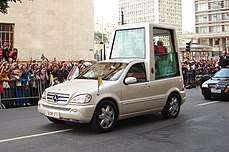
As pontiff, Benedict XVI carried out numerous Apostolic activities including journeys across the world and in the Vatican.
Benedict travelled extensively during the first three years of his papacy. In addition to his travels within Italy, Pope Benedict XVI made two visits to his homeland, Germany, one for World Youth Day and another to visit the towns of his childhood. He also visited Poland and Spain, where he was enthusiastically received.[143] His visit to Turkey, an overwhelmingly Muslim nation, was initially overshadowed by the controversy about a lecture he had given at Regensburg. His visit was met by nationalist and Islamic protesters[144] and was placed under unprecedented security measures.[145] However, the trip went ahead and Benedict made a joint declaration with Ecumenical Patriarch Bartholomew I in an attempt to begin to heal the rift between the Catholic and Orthodox churches.
In 2007, Pope Benedict visited Brazil in order to address the Bishops' Conference there and canonize Friar Antônio Galvão, an 18th-century Franciscan. In June 2007, Benedict made a personal pilgrimage and pastoral visit to Assisi, the birthplace of St. Francis. In September, Benedict undertook a three-day visit to Austria,[146] during which he joined Vienna's Chief Rabbi, Paul Chaim Eisenberg, in a memorial to the 65,000 Viennese Jews who perished in Nazi death camps.[147] During his stay in Austria, he also celebrated Mass at the Marian shrine Mariazell and visited Heiligenkreuz Abbey.[148]
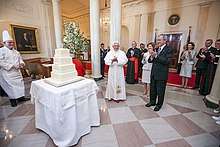
In April 2008, Pope Benedict XVI made his first visit to the United States since becoming pope.[149] He arrived in Washington, DC where he was formally received at the White House and met privately with U.S. President George W. Bush.[150] While in Washington, the pope addressed representatives of US Catholic universities, met with leaders of other world religions, and celebrated Mass at the Washington Nationals' baseball stadium with 47,000 people.[151] The Pope also met privately with victims of sexual abuse by priests. The Pope travelled to New York where he addressed the United Nations General Assembly.[152] Also while in New York, the Pope celebrated Mass at St. Patrick's Cathedral, met with disabled children and their families, and attended an event for Catholic youth, where he addressed some 25,000 young people in attendance.[153] On the final day of the Pope's visit, he visited the World Trade Center site and later celebrated Mass at Yankee Stadium.[154]
In July 2008, the Pope travelled to Australia to attend World Youth Day 2008 in Sydney. On 19 July, in St. Mary's Cathedral, he made an apology for child sex abuse perpetrated by the clergy in Australia.[155][156] On 13 September 2008, at an outdoor Paris Mass attended by 250,000 people, Pope Benedict XVI condemned the modern materialism – the world's love of power, possessions and money as a modern-day plague, comparing it to paganism.[157][158] In 2009, he visited Africa (Cameroon and Angola) for the first time as pope. During his visit, he suggested that altering sexual behavior was the answer to Africa's AIDS crisis, and urged Catholics to reach out and convert believers in sorcery. He visited the Middle East (Jordan, Israel and Palestine) in May 2009.
Pope Benedict's main arena for pastoral activity was the Vatican itself, his Christmas and Easter homilies and Urbi et Orbi are delivered from St Peter's Basilica. The Vatican is also the only regular place where Benedict XVI traveled via motor without the protective bulletproof case common to most popemobiles. Despite the more secure setting, Pope Benedict was victim to security risks several times inside Vatican City. On Wednesday, 6 June 2007 during his General Audience a man leapt across a barrier, evaded guards and nearly mounted the Pope's vehicle, although he was stopped and Benedict seemed to be unaware of the event. On Thursday, 24 December 2009, while Pope Benedict was proceeding to the altar to celebrate Christmas Eve Mass at St Peter's Basilica, a woman later identified as 25-year-old Susanna Maiolo, who holds Italian and Swiss citizenship, jumped the barrier and grabbed the Pope by his vestments and pulled him to the ground. The 82-year-old fell but was assisted to his feet and he continued to proceed towards the altar to celebrate Mass. Roger Etchegaray, 87, the vice-dean of the College of Cardinals, fell also and suffered a hip fracture. Italian police reported that the woman had previously attempted to accost the Pope at the previous Christmas Eve Mass, but was prevented from doing so.[159][160]
In his homily, Pope Benedict forgave Susanna Maiolo[161] and urged the world to "wake up" from selfishness and petty affairs, and find time for God and spiritual matters.[159]
Between 17 and 18 April, Pope Benedict made an Apostolic Journey to the Republic of Malta. Following meetings with various dignitaries on his first day on the island, 50,000 people gathered in a drizzle for Papal Mass on the granaries in Floriana. The Pope also met with the Maltese youth at the Valletta Waterfront, where an estimated 10,000 young people turned up to greet him.[162]
Sexual abuse in the Catholic Church
Prior to 2001, the primary responsibility for investigating allegations of sexual abuse and disciplining perpetrators rested with the individual dioceses. In 2001, Ratzinger convinced John Paul II to put the Congregation for the Doctrine of the Faith in charge of all investigations and policies surrounding sexual abuse in order to combat such abuse more efficiently.[163][164] According to John L. Allen, Jr., Ratzinger in the following years "acquired a familiarity with the contours of the problem that virtually no other figure in the Catholic Church can claim" and "driven by that encounter with what he would later refer to as 'filth' in the Church, Ratzinger seems to have undergone something of a 'conversion experience' throughout 2003–04. From that point forward, he and his staff seemed driven by a convert's zeal to clean up the mess".[165] In his role as Head of the CDF, he "led important changes made in Church law: the inclusion in canon law of internet offences against children, the extension of child abuse offences to include the sexual abuse of all under 18, the case by case waiving of the statute of limitation and the establishment of a fast-track dismissal from the clerical state for offenders."[166] As the Head of the CDF, Ratzinger developed a reputation for handling these cases. According to Charles J. Scicluna, a former prosecutor handling sexual abuse cases, "Cardinal Ratzinger displayed great wisdom and firmness in handling those cases, also demonstrating great courage in facing some of the most difficult and thorny cases, sine acceptione personarum (without exceptions)".[167][168]
One of the cases Ratzinger pursued involved Father Marcial Maciel Degollado, a Mexican priest and founder of the Legion of Christ, who had been accused repeatedly of sexual abuse. Biographer Andrea Tornielli suggested that Cardinal Ratzinger had wanted to take action against Maciel Degollado, but that John Paul II and other high-ranking officials, including several cardinals and notably the Pope's influential secretary Stanisław Dziwisz, prevented him from doing so.[164][169] According to Jason Berry, Angelo Sodano "pressured" Cardinal Ratzinger, who was "operating on the assumption that the charges were not justified", to halt the proceedings against Maciel in 1999.[170] When Maciel was honored by the Pope in 2004, new accusers came forward[170] and Cardinal Ratzinger "took it on himself to authorize an investigation of Maciel".[164] After Ratzinger became pope he began proceedings against Maciel and the Legion of Christ that forced Maciel out of active service in the Church.[163] On 1 May 2010, the Vatican issued a statement denouncing Maciel's "very serious and objectively immoral acts", which were "confirmed by incontrovertible testimonies" and represent "true crimes and manifest a life without scruples or authentic religious sentiment." Pope Benedict also said he would appoint a special commission to examine the Legionaries' constitution and open an investigation into its lay affiliate Regnum Christi.[171] Cardinal Christoph Schönborn explained that Ratzinger "made entirely clear efforts not to cover things up but to tackle and investigate them. This was not always met with approval in the Vatican".[163][172] According to Schönborn, Cardinal Ratzinger had pressed John Paul II to investigate Hans Hermann Groër, an Austrian cardinal and friend of John Paul accused of sexual abuse, resulting in Groër's resignation.[169]
In March 2010, the Pope sent a Pastoral Letter to the Catholic Church in Ireland addressing cases of sexual abuse by Catholic priests to minors, expressing sorrow, and promising changes in the way accusations of abuse are dealt with.[173] Victim groups claim the letter failed to clarify if secular law enforcement has priority over canon law confidentiality pertaining to internal investigation of abuse allegations.[174][175][176][177] The Pope then promised to introduce measures that would "safeguard young people in the future" and "bring to justice" priests who were responsible for abuse. In April, the Vatican issued guidelines on how existing Church law should be implemented. The guideline dictates that "Civil law concerning reporting of crimes... should always be followed."[178] The guideline was intended to follow the norms established by U.S. bishops, but it does not require the reporting of "allegations" or crimes where reporting is not required by law.[179]
Attire
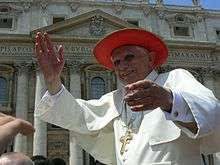
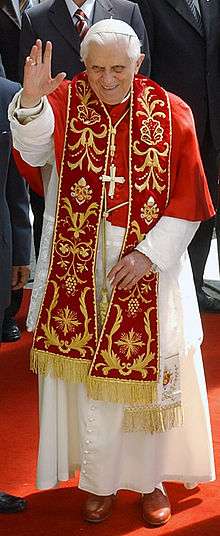
Pope Benedict XVI re-introduced several papal garments which had fallen into disuse. Pope Benedict XVI resumed the use of the traditional red papal shoes, which had been used since Roman times by popes but which had fallen into disuse during the pontificate of Pope John Paul II. Contrary to the initial speculation of the press that the shoes had been made by the Italian fashion house Prada, the Vatican announced that the shoes were provided by the Pope's personal shoemaker.[180]
On only one occasion, 21 December 2005, the Pope wore the camauro, the traditional red papal hat usually worn in the winter. It had not been seen since the pontificate of Pope John XXIII (1958–1963). On 6 September 2006, the Pope began wearing the red cappello romano (also called a saturno), a wide-brimmed hat for outdoor use. Rarely used by John Paul II, it was more widely worn by his predecessors.
The journalist Charlotte Allen describes Benedict as "the pope of aesthetics": "He has reminded a world that looks increasingly ugly and debased that there is such a thing as the beautiful—whether it's embodied in a sonata or an altarpiece or an embroidered cope or the cut of a cassock—and that earthly beauty ultimately communicates a beauty that is beyond earthly things."[18]
Health
Prior to his election as pope in 2005, Ratzinger had hoped to retire—on account of age-related health problems, a long-held desire to have free time to write, and the retirement age for bishops (75)—and submitted his resignation as Prefect of the Congregation for the Doctrine of the Faith three times, but continued at his post in obedience to the wishes of Pope John Paul II. In September 1991, Ratzinger suffered a hemorrhagic stroke, which slightly impaired his eyesight temporarily but which he recovered completely.[181] This was never officially made public—the official news was that Ratzinger had fallen and struck his head against a radiator—but was an open secret known to the conclave that elected him pope.[182]
Following his election in April 2005 there were several rumors about the Pope's health, but none of them were confirmed. Early in his pontificate Benedict XVI predicted a short reign, which led to concerns about his health.[183] In May 2005 the Vatican announced that he had suffered another mild stroke. French Cardinal Philippe Barbarin said that since the first stroke Ratzinger had been suffering from an age-related heart condition, for which he was on medication. In late November 2006 Vatican insiders told the international press that the Pope had had a routine examination of the heart.[182] A few days later an unconfirmed rumor emerged that Pope Benedict had undergone an operation in preparation for an eventual bypass operation, but this rumor was only published by a small left-wing Italian newspaper and was never confirmed by any Vatican insider.[184]
On 17 July 2009, Benedict was hospitalized after falling and breaking his right wrist while on vacation in the Alps; his injuries were reported to be minor.[185]
Following the announcement of his resignation, the Vatican revealed that Pope Benedict had been fitted with a pacemaker while he was still a cardinal, before his election as pope in 2005. The battery in the pacemaker had been replaced three months earlier, a routine procedure, but that did not influence his decision.[186]
In 2013 it was reported that Benedict has multiple health problems including high blood pressure and reportedly has fallen out of bed more than once, but the Vatican denied any specific illnesses.[187]
Resignation
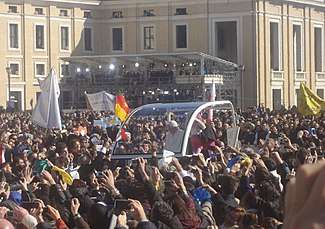
On 11 February 2013, the Vatican confirmed that Benedict XVI would resign the papacy on 28 February 2013, as a result of his advanced age,[188] becoming the first pope to resign since Gregory XII in 1415.[189] At the age of 85 years and 318 days on the effective date of his retirement, he was the fourth-oldest person to hold the office of pope. The move was unexpected.[190] In modern times, all popes have held office until death. Benedict was the first pope to resign without external pressure since Celestine V in 1294.[191][192]
In his declaration of 10 February 2013, Benedict XVI resigned as "Bishop of Rome, Successor of Saint Peter".[193] In a statement, Benedict cited his deteriorating strength and the physical and mental demands of the papacy;[194] addressing his cardinals in Latin, Benedict gave a brief statement announcing his resignation. He also declared that he would continue to serve the church "through a life dedicated to prayer".[194]
According to a statement from the Vatican, the timing of the resignation was not caused by any specific illness but was to "avoid that exhausting rush of Easter engagements".[195] After two weeks of ceremonial farewells, the Pope left office at the appointed time and sede vacante was declared.
On the eve of the first anniversary of Benedict's resignation he wrote to La Stampa to deny speculation he had been forced to step down. "There isn't the slightest doubt about the validity of my resignation from the Petrine ministry," he wrote in a letter to the newspaper. "The only condition for the validity is the full freedom of the decision. Speculation about its invalidity is simply absurd," he wrote.[196]
Pope Emeritus
On the morning of 28 February 2013, Pope Benedict met with the full College of Cardinals and in the early afternoon flew by helicopter to the papal summer residence of Castel Gandolfo. He stayed there until refurbishment was completed on his retirement home, the Mater Ecclesiae monastery in the Vatican Gardens near St Peter's, formerly home to 12 nuns, where he moved on 2 May 2013.[197] To protect it, there is a thick hedge and a fence. It has a garden of more than 2,000 square meters that overlooks the monastery and is adjacent to the current "Pope's garden". A few tens of meters away is the building of Vatican Radio.[198]
After his resignation, Benedict XVI retained his papal name rather than reverting to his birth name.[10] He continued to wear the white cassock but without the pellegrina or the fascia. He ceased wearing red papal shoes.[199][200] Benedict returned his official Fisherman's Ring, which is usually destroyed by Vatican officials on the death of a pope to prevent documents being counterfeited.
According to a Vatican spokesman, Benedict spent his first day as pope emeritus with Archbishop Georg Gänswein, the Prefect of the Papal Household.[201] In the monastery, the pope emeritus does not live a cloistered life, but studies and writes.[198] The pope emeritus joined his successor several months after his election at the unveiling of a new statue of Saint Michael the Archangel. The inscription on the statue, according to Cardinal Giovanni Lajolo, has the coat of arms of the two popes to symbolize the fact that statue was commissioned by Benedict XVI, and consecrated by Francis.[202]
Benedict XVI made his first public appearance after his resignation at St. Peter's Basilica on 22 February 2014 to attend the first papal consistory of his successor Pope Francis. Benedict XVI, who entered the basilica through a discreet entrance, was seated in a row with several other cardinals. He doffed his zucchetto when Pope Francis came down the nave of St. Peter's Basilica to greet him.[203] He then made an appearance at the canonization mass of Pope John XXIII and Pope John Paul II, greeting the cardinals and Pope Francis.
In August 2014, Benedict XVI celebrated Mass at the Vatican and met with his former doctoral students, an annual tradition he has kept since the 1970s.[204] He attended the beatification of Pope Paul VI in October 2014.[205] Weeks before this, he joined Pope Francis in Saint Peter's Square for an audience with grandparents to honor their importance in society.[206]
Benedict wrote the text of a speech, delivered by Archbishop Georg Gänswein, on the occasion of the dedication of the Aula Magna at the Pontifical Urbaniana University to the Pope Emeritus, "a gesture of gratitude for what he has done for the Church as a conciliar expert, with his teaching as professor, as Prefect of the Congregation for the Doctrine of the Faith and, finally, the Magisterium." The ceremony took place on Tuesday, 21 October 2014 during the opening of the academic year.[207]
Benedict XVI attended the consistory for new cardinals in February 2015, greeting Pope Francis at the beginning of the celebration.[208] In 2015, Benedict spent the summer at Castel Gandolfo and participated in two public events. "Pope Francis invited Benedict XVI to spend some time in Castel Gandolfo in the month of July and Benedict accepted", Fr. Lombardi told journalists on 15 June. Benedict XVI remained there for two weeks. While in Castel Gandolfo, Benedict received two honorary doctorates, given to him by Kraków's Cardinal Stanislaw Dziwisz, John Paul II's longtime aide, from the Pontifical University of John Paul II and the Kraków Academy of Music.[209] In his reception address, Benedict paid homage to his predecessor, John Paul II.[209]
The "Joseph Ratzinger–Benedict XVI Roman Library" at the Pontifical Teutonic College was announced in April 2015 and was scheduled to open to scholars in November 2015.[210] The library section dedicated to his life and thought is being catalogued. It includes books by or about him and his studies, many donated by Benedict himself.[211][212]
Benedict, in August 2015, submitted a handwritten card to act as a testimony to the cause of canonization of Pope John Paul I.[213][214]
In March 2016, he gave an interview expressing his views on mercy and endorsing Pope Francis's stress on mercy in his pastoral practice.[215] Also that month, a Vatican spokesman stated that Benedict was "slowly, serenely fading" in his physical health, although his mental capacity remained "perfectly lucid".[216]
The pope emeritus was honoured by the Roman Curia and Pope Francis in 2016 at a special audience, honouring the 65th anniversary of his ordination to the priesthood. Benedict, later that year in November, did not attend the consistory for new cardinals, though he did meet with them and Pope Francis at his residence after the consistory had taken place.[217]
On 28 June 2017, Benedict received the newly created cardinals in his chapel and "spoke with all of them in their native tongue" while also remarking that they were "from the four continents, the whole church". He further said that "The Lord wins in the end. Thank you all", he said, before giving them his blessing.[218]
In July 2017, Benedict sent a message through his private secretary Monsignor Gänswein for the occasion of the funeral of Cardinal Joachim Meisner, who had suddenly died while on vacation in Germany. In his message, the Pope Emeritus referred to Meisner as a "passionate shepherd and pastor" who found it "difficult to leave his post". The former pope also said that he had spoken on the telephone with Meisner the day before the latter died and related that Meisner was grateful to be on vacation after having been present for the beatification of Teofilius Matulionis in Vilnius.[219]
In November 2017, images emerged on the Facebook page of the Bishop of Passau Stefan Oster of Benedict with a black eye; the bishop and author Peter Seewald visited the former pope on 26 October since the pair were presenting Benedict with the new book Benedict XVI – The German Pope which the Passau diocese created. The former pope suffered the hematoma earlier after having slipped.[220]
On 13 January 2020, Benedict published a book expressing his view that the Church must maintain its discipline of clerical celibacy, in light of ongoing debate on the issue.[221]
Titles and styles
The official style of the former Pope in English is His Holiness Benedict XVI, Supreme Pontiff Emeritus or Pope Emeritus.[222] Less formally he is referred to as Emeritus Pope or Roman Pontifex Emeritus.[223] Moreover, according to the 1983 Code of Canon Law he is also Bishop Emeritus of Rome, retaining the sacred character received at his ordination as a bishop and receiving the title of emeritus of his diocese; although he doesn't use this style.[224] The pope Emeritus has personally preferred to be simply known as "Father”.[225]
As Pope, his rarely used full title was:
His Holiness Benedict XVI, Bishop of Rome, Vicar of Jesus Christ, Successor of the Prince of the Apostles, Supreme Pontiff of the Universal Church, Primate of Italy, Archbishop and Metropolitan of the Roman Province, Sovereign of the Vatican City State, Servant of the servants of God.[226]
The best-known title, that of "Pope", does not appear in the official list of titles, but is commonly used in the titles of documents, and appears, in abbreviated form, in their signatures as "PP." standing for "Papa" ("Pope").[227][228][229][230][231]
Before 1 March 2006, the list of titles also used to contain that of a "Patriarch of the West", which traditionally appeared in that list of titles before "Primate of Italy". The title of "Patriarch of the West" was first introduced into the papal court in 1870 at the time of the First Vatican Council in the publication Annuario Pontificio and was removed in the 2006 edition. Pope Benedict chose to remove the title at a time when discussions with the Orthodox churches have centered on the issue of papal primacy.[232]
Positions on morality and politics
Birth control and HIV/AIDS
In 2005, the pope listed several ways to combat the spread of HIV, including chastity, fidelity in marriage and anti-poverty efforts; he also rejected the use of condoms.[233] The alleged Vatican investigation of whether there are any cases when married persons may use condoms to protect against the spread of infections surprised many Catholics in the wake of John Paul II's consistent refusal to consider condom use in response to AIDS.[234] However, the Vatican has since stated that no such change in the Church's teaching can occur.[235] TIME also reported in its edition of 30 April 2006 that the Vatican's position remains what it always has been with Vatican officials "flatly dismiss[ing] reports that the Vatican is about to release a document that will condone any condom use."[235]
In March 2009, the pope stated:
I would say that this problem of AIDS cannot be overcome merely with money, necessary though it is. If there is no human dimension, if Africans do not help, the problem cannot be overcome by the distribution of prophylactics: on the contrary, they increase it. The solution must have two elements: firstly, bringing out the human dimension of sexuality, that is to say a spiritual and human renewal that would bring with it a new way of behaving towards others, and secondly, true friendship offered above all to those who are suffering, a willingness to make sacrifices and to practise self-denial, to be alongside the suffering.[236]
In November 2010, in a book-length interview, the pope, using the example of male prostitutes, stated that the use of condoms, with the intention of reducing the risk of HIV infection, may be an indication that the prostitute is intending to reduce the evil connected with his immoral activity.[237] In the same interview, the pope also reiterated the traditional teaching of the Church that condoms are not seen as a "real or moral solution" to the HIV/AIDS pandemic. Further, in December 2010, the Congregation of the Doctrine of the Faith explained that the pope's statement did not constitute a legitimization of either contraception or prostitution, which remains gravely immoral.[237]
Homosexuality
During his time as Prefect of the Congregation for the Doctrine of the Faith (CDF), Benedict XVI made several efforts to tackle the issue of homosexuality within the Church and the wider world. In 1986 the CDF sent a letter to all bishops entitled: On the Pastoral Care of Homosexual Persons. The letter condemned a liberal interpretation of the earlier CDF document Declaration on Certain Questions Concerning Sexual Ethics, which had led to a "benign" attitude "to the homosexual condition itself". On the Pastoral Care of Homosexual Persons clarified that the Church's position on homosexuality was that "although the particular inclination of the homosexual person is not a sin, it is a more or less strong tendency ordered toward an intrinsic moral evil; and thus the inclination itself must be seen as an objective disorder."[238] However the document also condemned homophobic attacks and violence, stating that "It is deplorable that homosexual persons have been and are the object of violent malice in speech or in action. Such treatment deserves condemnation from the Church's pastors wherever it occurs."[238]
In 1992, he again approved CDF documents declaring that homosexual "inclination itself must be seen as an objective disorder" and extended this principle to civil law. "Sexual orientation", the document said, was not equivalent to race or ethnicity, and it declared that it was "not unjust discrimination to take sexual orientation into account."[239]
On 22 December 2008, the pope gave an end-of-year message to the Roman Curia in which he talked about gender and the important distinction between men and women. The pope said that the Church viewed the distinction as central to human nature, and "asks that this order of creation be respected". The Church, he said, must "protect man from self-destruction." He said "something like a human ecology" was needed, adding: "Rain forests deserve indeed to be protected, but no less so does man". He attacked gender theories which he described as "man's attempt at self-emancipation from creation and the Creator."[240][241][242]
LGBT groups such as the Italian Arcigay and German LSVD have announced that they found the pope's comments homophobic.[243] Aurelio Mancuso, head of Arcigay, saying "A divine programme for men and women is out of line with nature, where the roles are not so clear."[241] Canadian author Daniel Gawthrop, in a critical biography, The Trial of Pope Benedict, said that the Pope blamed homosexuality "for a problem the church had willingly enabled for hundreds of years."[244]
Father Federico Lombardi, a Vatican spokesman, claimed the pope had not wished specifically to attack people with homosexual inclinations, and had not mentioned gays or lesbians in his text. Father Lombardi insisted that there had been an overreaction to the pope's remarks: "He was speaking more generally about gender theories which overlook the fundamental difference in creation between men and women and focus instead on cultural conditioning." Nevertheless, the remarks were interpreted as a call to save mankind from homosexuals and transsexuals.[241]
Same-sex marriage
During a 2012 Christmas speech,[245] the pope made remarks about the present-day interpretation of the notion of "gender". He stated that "sex is no longer a given element of nature, that man has to accept and personally make sense of: it is a social role that we choose for ourselves", and "The words of the creation account: "male and female he created them" (Gen 1:27) no longer apply". Although he didn't mention the topic, his words were interpreted by news media as denunciations of same-sex marriage,[246] with some sources adding that Benedict would have called it a threat to world peace similar to abortion and euthanasia.[247] In March 2012, he stated that heterosexual marriages should be defended from "every possible misrepresentation of their true nature".[248]
International relations
Migrants and refugees
In a message released 14 November 2006, during a Vatican press conference for the 2007 annual observance of World Day for Migrants and Refugees, the Pope urged the ratification of international conventions and policies that defend all migrants, including refugees, exiles, evacuees and internally displaced persons. "The church encourages the ratification of the international legal instruments that aim to defend the rights of migrants, refugees and their families," the Pope said. "Much is already being done for the integration of the families of immigrants, although much still remains to be done."[249]
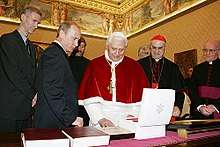
Pope Benedict also promoted various UN events, such as World Refugee Day, on which he offered up special prayers for refugees and called for the international community to do more to secure refugees' human rights. He also called on Catholic communities and organizations to offer them concrete help.[250]
In 2015, it was reported that Benedict was "praying for migrants and refugees" from Syria.[251]
China
In 2007, Benedict sent a letter at Easter to Catholics in China that could have wide-ranging implications for the church's relationship with China's leadership. The letter provides long-requested guidance to Chinese bishops on how to respond to illicitly ordained bishops, as well as how to strengthen ties with the Patriotic Association and the Communist government.[252]
Korea
On 13 November 2006, Benedict said that the dispute over the North Korea nuclear weapons program should be resolved through negotiations, in his first public comment on the security issue, a news report said. "The Holy See encourages bilateral or multilateral negotiations, convinced that the solution must be sought through peaceful means and in respect for agreements taken by all sides to obtain the denuclearisation of the Korean Peninsula." Benedict was talking to the new Japanese ambassador to the Vatican.[253]
Turkey
In a 2004 Le Figaro interview, Ratzinger said that Turkey, which is demographically Muslim but governmentally secular by virtue of its state constitution, should seek its future in an association of Muslim nations rather than the European Union, which Ratzinger stated has Christian roots. He said Turkey had always been "in permanent contrast to Europe and that linking it to Europe would be a mistake".[254]
Later visiting the country to "reiterate the solidarity between the cultures," it was reported that he made a counter-statement backing Turkey's bid to join the EU. Prime Minister of Turkey Recep Tayyip Erdoğan, said that the Pope told him in their meeting that while the Vatican seeks to stay out of politics it desires Turkey's membership in the EU.[255][256] However, the Common Declaration of Pope Benedict XVI and Patriarch Bartholomew I of Constantinople implied that support for Turkey's membership in the European Union would be contingent on the establishment of religious freedom in Turkey:[257] "In every step towards unification, minorities must be protected, with their cultural traditions and the distinguishing features of their religion."[258] The Declaration also reiterates Pope Benedict XVI's call for Europe to preserve its Christian roots.
Israel
In May 2009, he visited Israel.[259][260] This was the third Papal visit to the Holy Land, the previous ones being made by Pope Paul VI in 1964 and Pope John Paul II in 2000.
Vietnam
Pope Benedict XVI and Prime Minister Nguyễn Tấn Dũng met at the Vatican on 25 January 2007 in a "new and important step towards establishing diplomatic ties".[261] The Pope met with President Nguyễn Minh Triết on 11 December 2009. Vatican officials called the meeting "a significant stage in the progress of bilateral relations with Vietnam."[262]
Global economy
In 2009, the Pope intervened in global economic and political affairs with his third encyclical, Charity in Truth (Latin Caritas in veritate), which can be viewed on the Vatican's web site.[263] This document set out the then reigning Pope's position on the case for worldwide redistribution of wealth in considerable detail and goes on to discuss the environment, migration, terrorism, sexual tourism, bioethics, energy and population issues. The Financial Times reported that Benedict XVI's advocacy for a fairer redistribution of wealth helped set the agenda for the 2009 July G8 summit.[264][265]
Also included in Charity in Truth is advocacy for tax choice:
One possible approach to development aid would be to apply effectively what is known as fiscal subsidiarity, allowing citizens to decide how to allocate a portion of the taxes they pay to the State. Provided it does not degenerate into the promotion of special interests, this can help to stimulate forms of welfare solidarity from below, with obvious benefits in the area of solidarity for development as well.[263]
Nuclear energy
Pope Benedict XVI called for nuclear disarmament. At the same time, he supported the peaceful use of nuclear energy as a tool for development and the fight against poverty. In his message for the 50th anniversary of the founding of the International Atomic Energy Agency, he confirmed: "The Holy See, fully approving of the IAEA's goal, has been a member from the organisation's foundation and continues to support its activity."[266]
Interests
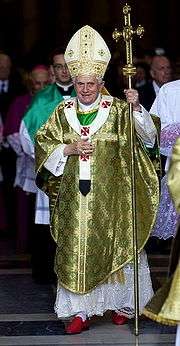
Benedict is known to be deeply interested in classical music,[23] and is an accomplished pianist.[267] His favorite composer is Wolfgang Amadeus Mozart, of whose music he said: "His music is by no means just entertainment; it contains the whole tragedy of human existence."[268] Benedict also stated that Mozart's music affected him greatly as a young man and "deeply penetrated his soul".[268] Benedict's favorite works of music are Mozart's Clarinet Concerto and Clarinet Quintet.[269] He recorded an album of contemporary classical music in which he sings and recites prayers to the Blessed Virgin Mary.[270] The album was set for release on 30 November 2009.
He is also known to be fond of cats.[23] As Cardinal Ratzinger he was known (according to former neighbours) to look after stray cats in his neighbourhood. A book called Joseph and Chico: A Cat Recounts the Life of Pope Benedict XVI was published in 2007 which told the story of the Pope's life from the feline Chico's perspective. This story was inspired by an orange tabby Pentling cat, which belonged to the family next door.[271] During his trip to Australia for World Youth Day in 2008 the media reported that festival organizers lent the Pope a grey cat called Bella[272] in order to keep him company during his stay.[273]
Social networking
In December 2012, the Vatican announced that Pope Benedict XVI had joined social networking website Twitter, under the handle @Pontifex.[274] His first tweet was made on 12 December and was "Dear friends, I am pleased to get in touch with you through Twitter. Thank you for your generous response. I bless all of you from my heart."[275] On 28 February 2013, the day he retired, the tweets were archived, and @Pontifex read "Sede Vacante".[276] Pope Francis eventually took control of the @Pontifex account upon his election.[277]
Honours and awards
As pope, Benedict was Grand Master of the following orders: Supreme Order of Christ, Order of the Golden Spur, Order of Pius IX, Equestrian Order of St. Gregory the Great and the Order of St. Sylvester.
- 1977 Grand Cross of the National Order of Merit of the Republic of Ecuador
- 1977 Knight Grand Cross of the Bavarian Order of Merit
- 1985 Grand Merit Cross with Star and Sash of the Federal Republic of Germany
- 1985 Bayerische Verfassungsmedaille (Bavarian Constitution Medal) in Gold
- 1989 Order of Minerva at the D'Annunzio University of Chieti–Pescara
- 1989 Augustin Bea Prize (Rome)
- 1989 Karl-Valentin-Orden (Munich)
- 1991 Leopold Kunschak Prize (Vienna)
- 1991 Georg von Hertling Medal of Kartellverband katholischer deutscher Studentenvereine
- 1992 Grand Decoration of Honour in Gold with Sash for Services to the Republic of Austria
- 1992 Literature Prize Capri S. Michele in Anacapri
- 1992 Premio Internazionale di Cultura Cattolica, Bassano del Grappa
- 1993 literary prize Premio Letterario Basilicata per la Letteratura e Poesia religiosa Spirituale in Potenza (Italy)
- 1996 Knight of the Bavarian Maximilian Order for Science and Art
- 1998 Commander of the Legion of Honour (Légion d'honneur) (France)
- 1999 Bailiff Grand Cross of Honour and Devotion of the Sovereign Military Order of Malta
- 2002 Liberal Trieste
- 2004 Literature Prize Capri S. Michele in Anacapri
- Honorary doctorates
- 1984 University of St. Thomas (St. Paul, Minnesota, USA; Honorary Doctor of Human Letters)
- 1986 Pontificia Universidad Catolica del Peru (Pontifical Catholic University of Peru)
- 1987 Catholic University of Eichstätt-Ingolstadt
- 1988 Katolicki Uniwersytet Lubelski (Catholic University of Lublin, Poland)
- 1998 University of Navarra (Pamplona, Spain)
- 1999 Libera Università Maria SS Assunta Roma (Maria SS Assunta Free University, Rome) (honorary degree in law)
- 2000 Uniwersytet Wrocławski (University of Wroclaw, Poland; Honorary Doctor of Theology)
- 2005 Universatea Babes-Bolyai in Cluj-Napoca (Babeș-Bolyai University)
- Honorary citizenships
- 1987 Pentling, near Regensburg, location of his main German residence
- 1997 Marktl, his birthplace
- 2005 Traunstein, location of the school and the study seminar he attended
- 2006 Altötting, in Bavaria
- 2006 Regensburg, worked as a full, later as a visiting, professor
- 2006 Aschau am Inn, started school and received Mass for the first time
- 2007 Tittmoning, where he spent part of his childhood
- 2008 Brixen, where he holidayed several times as a cardinal and as pope
- 2009 Mariazell, whose sanctuary he visited in 2007 as pope
- 2009 Introd in the Aosta Valley, where he spent some of his summer holidays in 2005, 2006 and 2009
- 2010 Romano Canavese, in Piedmont[278]
- 2010 Lisbon, honoring his visit to the city on 11–12 May 2010[279]
- 2010 Freising, where he studied, was ordained a priest in 1951, where he served from 1954 to 1957 lecturer at the Philosophical and Theological College and worked from 1977 to 1982 as archbishop of Munich and Freising
- 2011 Natz-Schabs in South Tyrol; Benedict's grandmother Maria Tauber Peintner and his great-grandmother Elisabeth Maria Tauber both come from Natz-Schabs
The asteroid 8661 Ratzinger was named in his honor for the role he played in supervising the opening of Vatican archives in 1998 to researchers investigating judicial errors against Galileo and other medieval scientists. The name was proposed by the asteroid's first discoverers, L. D. Schmadel and F. Borngen at Tautenburg.[280]
Arms
 |
|
Writings
Pope Benedict XVI has written 66 books, three encyclicals, and three apostolic exhortations.
See also
- Cardinals created by Benedict XVI
- Papal regalia and insignia – papal attire
- Three Secrets of Fátima – document on the release of the Third Secret of Fátima
Citations
- "Biography of His Holiness Pope Benedict XVI". Vatican.va. Retrieved 9 October 2012.
- Thomas P. Rausch, SJ (2015). Faith, Hope, and Charity: Benedict XVI on the Theological Virtues. Paulist Press. ISBN 9781587684883.
To a certain extent I am a Platonist. I think that a kind of memory, of recollection of God, is, as it were, etched in man, though it needs to be awakened.
- Pope Benedict XVI (12 March 2008), Boethius and Cassiodorus, archived from the original on 28 December 2008, retrieved 4 November 2009
- "Udienza Generale del 18 aprile 2007: Clemente Alessandrino | Benedetto XVI". w2.vatican.va.
- "General Audience of 14 May 2008: Pseudo-Dionysius, the Areopagite | BENEDICT XVI". w2.vatican.va.
- "General Audience, 23 August 2006: John, "the Seer of Patmos" | BENEDICT XVI". w2.vatican.va.
- "General Audience of 4 May 2011: Man in Prayer (1) | BENEDICT XVI". w2.vatican.va.
- BENEDICT XVI GENERAL AUDIENCE Saint Teresa of Avila 2 February 2011
- Pope Benedict XVI 2007, pp. 24–27.
- "Benedict XVI will be 'Pope emeritus'". The Vatican Today. Retrieved 28 February 2013.
Benedict XVI will be "Pontiff emeritus" or "Pope emeritus", as Fr. Federico Lombardi, S.J., director of the Holy See Press Office, reported in a press conference on the final days of the current pontificate. He will keep the name of "His Holiness, Benedict XVI" and will dress in a simple white cassock without the mozzetta (elbow-length cape).
- Petin, Edward (26 February 2013). "Benedict's New Name: Pope Emeritus, His Holiness Benedict XVI, Roman Pontiff Emeritus". Retrieved 23 June 2018.
- Walsh, Mary Ann (2005). From Pope John Paul II to Benedict XVI: an inside look at the end of an era, the beginning of a new one, and the future of the church. Rowman & Littlefield. p. 135. ISBN 1-58051-202-X.
- Owen, Richard (6 June 2008). "Vatican to publish entire work by bestselling author Pope Benedict XVI". The Times. London. Retrieved 10 February 2019.
- "Disillusioned German Catholics: From Liberal to Conservative". Der Spiegel. Retrieved 17 February 2013.
- Johnston, Jerry Earl (18 February 2006). "Benedict's encyclical offers hope for world". Deseret News. Archived from the original on 2 April 2015. Retrieved 12 September 2010. WebCitation archive
- Gledhill, Ruth "Pope set to bring back Latin Mass that divided the Church" The Times 11 October 2006. Retrieved 21 November 2010 WebCitation archive
- Tom Kington in Rome (31 August 2012). "Pope Benedict to open new Latin academy in the Vatican". The Guardian. London. Retrieved 12 March 2013.
- Allen, Charlotte (17 February 2013). "Pope Benedict XVI, the pontiff of aesthetics". Los Angeles Times. Retrieved 17 February 2013.
- "Men in White: Pope to meet Benedict XVI". The Sydney Morning Herald.
- "World Over – 23 February 2013 – Cardinal Joseph Ratzinger Interview Special with Raymond Arroyo". EWTN Television. Retrieved 23 May 2013.
- "Announcement of Pope Benedict XVI's resignation in Latin". Vatican YouTube Channel. Retrieved 23 May 2013.
- "Pope Benedict XVI: Quick Facts". United States Conference of Catholic Bishops. Retrieved 4 November 2007.
- Willey, David (13 May 2005). "Pope Benedict's creature comforts". BBC News. Retrieved 2 February 2010. WebCitation archive
- "Vatican Radio – Pope Benedict: proud to be part of Tyrol a "land made by Angels"". En.radiovaticana.va. 9 November 2011. Archived from the original on 17 May 2013. Retrieved 17 February 2013.
- Mrugala, Anette (10 July 2009). ""Papst-Schule" eingeweiht" ["Pope school" opened] (in German). Innsalzach24.de. Archived from the original on 31 March 2012. Retrieved 17 September 2011.
- Landler, Mark; Bernstein, Richard (22 April 2005). "A Future Pope Is Recalled: A Lover of Cats and Mozart, Dazzled by Church as a Boy". The New York Times.
- Zweite Durchführungsverordnung zum Gesetz über die Hitler-Jugend (Jugenddienstverordnung) vom 25. März 1939 (§ 1)
- "New Pope Defied Nazis As Teen During WWII". USA Today. Associated Press. 23 April 2005. Archived from the original on 4 January 2012. Retrieved 10 July 2009.
- Allen, John (14 October 2005). "Anti-Nazi Prelate Beatified". The Word from Rome. National Catholic Reporter. Retrieved 15 April 2008.
- Pope Benedict XVI; Thornton, John F.; Varenne, Susan B. (2007). The Essential Pope Benedict XVI: His Central Writings and Speeches. HarperCollins. pp. xxxix and xl. ISBN 978-0-06-112883-7. "Chronology of the Life of Pope Benedict XVI" Online version available at Google Books. Retrieved 26 January 2011
- "Pope Recalls Being German POW". Fox News. Archived from the original on 7 June 2013. Retrieved 9 December 2018.
- Joseph Cardinal Ratzinger; Erasmo Leiva-Merikakis (translator) (1998). Milestones: Memoirs 1927–1977 (in German). Ignatius Press. p. 99. ISBN 978-0-89870-702-1.
- "Ratzinger and Guardini, a Decisive Encounter" essay by Silvano Zucal in Vita E Pensiero Publisher Catholic University of Milan, 1 October 2008
- "The Lord" by Roman Guardini, 1996, reprint of 1954 first English translation Regnery Publishing
- Van Biema, David (24 April 2005). "The Turning Point". Time. Archived from the original on 15 December 2011. Retrieved 7 October 2011.
- Wakin, Daniel J.; Bernstein, Richard; Landler, Mark (24 April 2005). "Turbulence on Campus in 60's Hardened Views of Future Pope". The New York Times. Archived from the original on 16 April 2009. Retrieved 8 June 2005.
- Ostling, Richard N.; Moody, John; Morris, Nomi (6 December 1993). "Keeper of the Straight and Narrow". Time. Archived from the original on 23 August 2012. Retrieved 10 July 2009.
- Dulles, s.j., Avery (October 1983). "The Catholicity of the Augsburg Confession". The Journal of Religion. 63 (4): 337–354. doi:10.1086/487060. JSTOR 1203403.
- Fahlbusch, Erwin; Bromiley, Geoffrey William; Barrett, David B. (1999). "Evangelical Catholicity". The Encyclopedia of Christianity. Grand Rapids: Wm. B. Eerdmans Publishing. ISBN 90-04-11695-8.
- "Cardinal Schönborn Explains What Ratzinger Students Will Discuss | ZENIT – The World Seen From Rome". ZENIT. 30 August 2012. Retrieved 20 February 2013.
- Alexander, Fr (31 August 2012). "Ecumenism is of 'primary importance' to the Pope, says Cardinal Schönborn". Catholic Herald. Archived from the original on 30 April 2013. Retrieved 20 February 2013.
- CNS. "Pope Benedict One of Most Respected Theologians". Georgiabulletin.org. Archived from the original on 4 September 2011. Retrieved 17 February 2013.
- Thavis, John; Wooden, Cindy (19 April 2005). "Cardinal Ratzinger, guardian of church doctrine, elected 265th pope". Catholic News Service. Archived from the original on 7 September 2011. Retrieved 17 July 2009.
- theology → Biography Joseph Cardinal Ratzinger / Pope Benedict XVI → Mitgliedschaften → EuropAcad → 1991
- Biography of Joseph Cardinal Ratzinger / Pope Benedict XVI Archived 4 March 2016 at the Wayback Machine → Mitgliedschaften → EuropAcad → 1991
- "Dominus Iesus".
- Doward, Jamie (24 April 2005). "Pope 'obstructed' sex abuse inquiry". The Observer. London. Retrieved 14 July 2007. WebCitation archive
- Sex Crimes and the Vatican (Quotation from an October 2006 BBC documentary):
The man in charge of enforcing it for 20 years was Cardinal Joseph Ratzinger, the man made Pope last year. In 2001 he created the successor to the decree.
- "UK Bishops Angered by BBC Attack on Pope". Eternal Word Television Network. Catholic News Agency. 2 October 2006. Archived from the original on 28 January 2011. Retrieved 14 April 2008.
- "Pope seeks immunity in Texas abuse case", The Sydney Morning Herald 17 August 2005. Retrieved 8 October 2011 WebCitation archive
- Caldwell, Simon "Pope Benedict wanted to be a librarian" The Daily Telegraph, 5 August 2010. Retrieved 21 August 2011 WebCitation archive
- "Cardinal Ratzinger asked to resign in 1997, become Vatican librarian".
- Sullivan, Andrew (18 April 2005). "Time 100 2005". Time. Retrieved 3 April 2013.
- Goodstein, Laurie and Elisabetta Povoledo (11 March 2013). "Before Smoke Rises at Vatican, It's Romans vs. the Reformers". New York Times.
- Ivereigh, Austen (11 March 2013). "Does cardinal confusion spell a long conclave?". Our Sunday Visitor. Archived from the original on 16 March 2013. Retrieved 12 March 2013.
- Cormac Murphy-O'Connor speaking on BBC Radio 4's Midweek 13 May 2015
- Pizzey, Allen "Benedict: I Prayed Not To Be Pope" CBS News 11 February 2009. Retrieved 21 August 2011 WebCitation archive
- "Election – BENEDICT XVI".
- "General Audience of 27 April 2005 – BENEDICT XVI".
- "Response of His Holiness Benedict XVI for the examination of the cause for beatification and canonization of the Servant of God John Paul II". Vatican.va. 9 May 2005. Archived from the original on 10 November 2011. Retrieved 2 February 2010.
- Drummer, Alexander (13 May 2005). "Waiting Period Waived for John Paul II". Zenit News Agency. Archived from the original on 1 October 2012. Retrieved 24 September 2011.
- Drummer, Alexander (28 June 2005). "John Paul II's Cause for Beatification Opens". Zenit News Agency. Archived from the original on 7 June 2011. Retrieved 24 September 2011.
- "Our Founder". Congregation of Holy Cross. 24 August 2011. Archived from the original on 16 October 2011. Retrieved 8 October 2011.
- "Pope beatifies Cardinal Newman as his UK tour ends (with video clip)". BBC News. 19 September 2010.
- "Communiqué on beatification process". Vatican.va. 29 September 2005. Archived from the original on 3 November 2011. Retrieved 2 February 2010.
- "Canonization of the Blesseds". Vatican.va. 23 October 2005. Archived from the original on 18 October 2011. Retrieved 2 February 2010.
- "Pope Schedules Five Canonizations for May–June". EWTN. 23 February 2007. Archived from the original on 6 December 2010. Retrieved 2 February 2010.
- "Malta to get its first saint". CathNews. 2 March 2007. Archived from the original on 20 January 2012. Retrieved 8 October 2011.
- "Pope Announces Canonisation of India's First Native Woman Saint". Vatican Radio. 1 March 2008. Retrieved 3 August 2013.
- "26 April 2009: Holy Mass for the Canonization of Arcangelo Tadini, Bernardo Tolomei, Nuno de Santa Maria Alvares Pereira, Gertrude Comensoli and Caterina Volpicelli – BENEDICT XVI".
- "Pope canonises 'lepers' apostle' and four others". Archived from the original on 25 September 2012. Retrieved 26 January 2011.
- "11 October 2009: Canonization of five new Saints: Zygmunt Szczęsny Feliński, Francisco Coll y Guitart, Josef Daamian de Veuster, Rafael Arnáiz Barón, Marie de la Croix (Jeanne) Jugan – BENEDICT XVI".
- Winfield, Nicole "Pope Creates First Australian Saint, 5 Others" AOL News 17 October 2010. Retrieved 26 January 2011 WebCitation archive
- Kerr, David "Pope Benedict canonizes three new saints"
- Glatz, Carol "Pope advances sainthood causes of Kateri Tekakwitha, others" Archived 30 June 2013 at the Wayback Machine The Tidings Online 23 December 2011. Retrieved 13 January 2012
- Donadio, Rachel "Pope Canonizes 7 Saints, Including 2 Women With New York Ties" The New York Times 21 October 2012. Retrieved 4 November 2012
- "Pope names 2 church doctors: preacher St. John of Avila and mystic St. Hildegard of Bingen". Fox News Channel. 26 June 2012. Retrieved 9 October 2012.
- Allen Jr., John L. (30 May 2006). "Council for Interreligious Dialogue to be restored, Vatican says". National Catholic Reporter. Retrieved 2 September 2016.
- "Pope appoints Archbishop Fisichella to lead Council for New Evangelization". Catholic News Agency. 30 June 2010. Retrieved 2 September 2016.
- "Pope transfers responsibility for catechesis, seminaries". Catholic News Agency. 25 January 2013. Retrieved 2 September 2016.
- Beach, Kevin "What is the role of the Pope?" Catholic Mission Leaflets WebCitation archive
- "Mass for the Inauguration of the Pontificate of Pope Benedict XVI – Homily of His Holiness Pope Benedict XVI". Vatican.va. 24 April 2005. Archived from the original on 1 November 2011. Retrieved 2 February 2010.
- "To the Clergy of Rome, with Response to Interventions by Roman Clergy". EWTN. 13 May 2005. Archived from the original on 9 July 2011. Retrieved 2 February 2010.
- "For Electing the Supreme Pontiff". EWTN. 18 April 2005. Archived from the original on 15 November 2011. Retrieved 2 February 2010.
- Drummer, Alexander (15 April 2007). "Benedict XVI's Book a Pastoral Work". Zenit News Agency. Archived from the original on 1 October 2012. Retrieved 24 September 2011.
- "ST JOSEMARÍA".
- Drummer, Alexander (7 February 2006). "The Secret of Love, According to Benedict XVI – Pope Explains Encyclical to Readers of Italian Magazine". Zenit News Agency. Archived from the original on 11 August 2011. Retrieved 8 October 2011.
- Ratzinger, Joseph Relativism: The Central Problem for Faith Today EWTN May 1996. Retrieved 8 October 2011 WebCitation archive
- "Address of His Holiness Benedict XVI to the participants in the Ecclesial Diocesan Convention of Rome" 6 June 2005 Retrieved 8 October 2011 WebCitation archive
- Allen, Jr., John L. (21 August 2005). "Coverage of World Youth Day exclusively by NCR Report #4: Do-it-yourself religion 'cannot ultimately help us,' pope tells youth". National Catholic Reporter. Archived from the original on 27 September 2011. Retrieved 2 February 2010.
- Ratzinger, Joseph (2003). Truth And Tolerance: Christian Belief And World Religions. Ignatius Press. ISBN 1-58617-035-X.
- "Apostolic Journey to Cologne: Vigil with youth at Marienfeld area (August 20, 2005) – BENEDICT XVI".
- "NewsMax Archives". Archived from the original on 9 June 2012.
- Drummer, Alexander (29 July 2005). "Cardinal Ratzinger on Europe's Crisis of Culture (Part 4)". Zenit News Agency. Archived from the original on 1 October 2012. Retrieved 24 September 2011.
- "Deus caritas est". Vatican.va. 25 December 2005. Archived from the original on 8 October 2011. Retrieved 2 February 2010.
- Fisher, Ian "Benedict's First Encyclical Shuns Strictures of Orthodoxy" The New York Times 26 January 2006. Retrieved 5 October 2011 WebCitation archive
- Thavis, John "The pope needs a theologian? Former papal adviser reveals why" Catholic News Service 30 December 2005. Retrieved 5 October 2011 WebCitation archive
- McMahon, Barbara "Vatican invokes papal copyright" The Guardian 22 January 2006. Retrieved 5 October 2011 WebCitation archive
- Thavis, John (30 November 2007). "People need God to have hope, pope in new encyclical". Catholic News Service. Archived from the original on 11 October 2012. Retrieved 2 February 2010.
- "Spe salvi (November 30, 2007) – BENEDICT XVI".
- Donadio, Rachel (7 July 2009). "Pope Urges Forming New World Economic Order to Work for the 'Common Good'". The New York Times. Archived from the original on 23 December 2011. Retrieved 7 July 2009.
- Speciale, Alessandro (4 July 2013). "The light of faith: origin, history and horizon of the christianism". La Stampa. Turin. Retrieved 19 October 2013.
- Lumen Fidei, 7
- "Sacramentum Caritatis: Post-Synodal Apostolic Exhortation on the Eucharist as the Source and Summit of the Church's Life and Mission (22 February 2007) – BENEDICT XVI".
- "Pope Allows Worldwide Use of Old Latin Mass". Catholic Information Service for Africa. 10 July 2007.
- Pope Benedict XVI. "Letter of His Holiness Benedict XVI to the Bishops on the Occasion of the Publication of the Apostolic Letter Motu Proprio Data Summorum Pontificum, On the Use of the Roman Liturgy Prior to the Reform of 1970". Archived from the original on 10 October 2011.
- Article 5 §4 of the motu proprio
- Burke, Jason (9 July 2007). "Criticism over return of Latin Mass". The Hindu. Chennai, India. Archived from the original on 8 November 2012. Retrieved 4 October 2011.
- "Pontifical Commission 'Ecclesia Dei'". Vatican.va. Archived from the original on 11 September 2011. Retrieved 14 June 2010.
- Winfield, Nicole (10 July 2007). "Pope: Other Christians not true churches". USA Today. Associated Press. Archived from the original on 14 November 2009. Retrieved 18 September 2011.
- "Children in consumerist societies "risk losing hope," says Pope Benedict". Catholic News Agency. 10 December 2007. Archived from the original on 29 July 2013. Retrieved 4 October 2011.
- "Caritas in veritate Encyclical Letter of 29 June 2009". Vatican.va. Archived from the original on 2 September 2011. Retrieved 2 February 2010.
- "Common Declaration of Pope Benedict XVI and the Archbishop of Canterbury His Grace Rowan Williams". Vatican.va. 23 November 2006. Retrieved 17 February 2013.
- "ADL Welcomes Election of Cardinal Ratzinger as New Pope". Archived from the original on 15 January 2013.
- "In quotes: Reaction to Pope election". BBC News. 20 April 2005. Retrieved 31 January 2009. WebCitation archive
- "Vatican to release Benedict XVI's letter on the use of the Tridentine Mass tomorrow". Catholicnewsagency.com. 6 July 2007. Retrieved 17 February 2013.
- "Mikulanis says ADL jumped gun, got its facts wrong" San Diego Jewish World. Vol. 1, Number 67. 6 July 2007. Retrieved 2 October 2011 WebCitation archive
- Paulson, Michael (24 February 2009). "O'Malley meets Jews over Holocaust flap". Boston Globe. Archived from the original on 26 February 2009. Retrieved 20 June 2009.
- "What Is Not True About the Good Friday Prayer for Jews". Zenit News Agency. 27 January 2009. Archived from the original on 9 November 2011. Retrieved 20 June 2009.
- Cernera, Anthony J. and Eugene Korn (26 November 1986). "The Latin Liturgy and the Jews". America. Archived from the original on 12 June 2011. Retrieved 2 February 2010.
- "BBC News – Seminary sacks 'Holocaust bishop'".
- Willan, Philip. "Pope readmits Holocaust-denying priest to the church" The Independent 25 January 2009. Retrieved 1 June 2009 WebCitation archive
- Wensierski, Peter "Williamson's Colleagues Under Fire: SSPX in Germany Criticized over Anti-Semitic Statements" Der Spiegel. 10 February 2009. Retrieved 29 May 2009. WebCitation archive
The latest issue of the SSPX's newsletter for German-speaking countries ... contains several anti-Semitic statements. 'The Jewish people were once the chosen people. But the majority of the people denied the Messiah on his first coming,' reads the February issue's cover story .... According to the newsletter article, this is why the Bible's Gospel of Matthew states, 'His blood be upon us and upon our children,' a phrase historically used by some Christians to justify anti-Semitism.
- "The Society of St. Pius X: Mired in Antisemitism" Archived 16 January 2013 at the Wayback Machine The Anti-Defamation League 26 January 2009. Retrieved 29 May 2009 "SSPX has promoted theological and conspiratorial anti-Semitism among its adherents."
- Liphshiz, Cnaan "Report: Vatican readmits society that propagates anti-Semitism". Haaretz. 19 February 2009. Archived from the original on 10 November 2011. Retrieved 3 October 2011. Haaretz 19 February 2009. Retrieved 2 October 2011 "The [web]site from Germany ... clarifies that 'contemporary Jews are for sure guilty of the murder of God, as long as they don't recognise Christ as God.'"
- "BBC NEWS – Europe – In quotes: Muslim reaction to Pope".
- "Pope sorry for offending Muslims". BBC News. 17 September 2006. Archived from the original on 20 August 2011. Retrieved 2 February 2010.
- "Apostolic Journey to München, Altötting and Regensburg: Meeting with the representatives of science in the Aula Magna of the University of Regensburg (September 12, 2006) – BENEDICT XVI".
- "The Pope, Jihad, and 'Dialogue'" Bostom, Andrew G. American Thinker 17 September 2006. Retrieved 20 November 2010 WebCitation archive
- "Apostolische Reise nach München, Altötting und Regensburg: Treffen mit den Vertretern der Wissenschaft in der Aula Magna der Universität Regensburg (12. September 2006) – BENEDIKT XVI".
- "Pope to hold seminar with Muslims".
- "Final Statement of Catholic-Muslim Forum". Zenit. 6 November 2008. Archived from the original on 8 June 2011. Retrieved 2 October 2011.
- Saleh, Fakhri "Arab Reactions to the Pope's Visit Signs of Hope" Qantara.de 18 May 2009. Retrieved 3 February 2011 WebCitation archive
- "His Holiness the Dalai Lama Greets New Pope".
- "Italy: China blamed for absence of Papal audience for Dalai Lama", Adnkronos, 27 November 2007. Retrieved 19 June 2009
- Fisher, Ian (23 May 2007). "Pope Softens Remarks on Conversion of Natives". The New York Times. Archived from the original on 5 June 2015. Retrieved 2 October 2011.
- Fisher, Ian "Pope tries to quell anger over speech he gave in Brazil", The New York Times, 23 May 2007. Retrieved 2 October 2011 WebCitation archive
- Smith, Peter "ISKCON Scholar To Meet With The Pope" ISKCON News 31 March 2008. Retrieved 2 October 2011 WebCitation archive
- "ISKCON News". Archived from the original on 6 July 2008.
- "Bhaktivedanta College".
- "ISKCON News". Archived from the original on 6 June 2013.
- Alexander, David "Despite missteps, pope reaching out to other faiths" Reuters 15 April 2008. Retrieved 2 October 2011 WebCitation archive
- Israely, Jeff "The Pope Squares Off With Spain's Secular Champion" "No doubt Benedict was buoyed by the enthusiastic welcome he received in Valencia." Time 9 July 2006. Retrieved 20 November 2010 WebCitation archive
- Moore, Molly. "Turks Protest Pope's Coming Visit", The Washington Post, 27 November 2006. Retrieved 13 May 2008. WebCitation archive
- "Massive security for Pope's Turkey visit". Breaking News. 28 November 2006.
- Vatican Radio "Pope Benedict XVI Going to Vienna" 7 September 2007. Retrieved 26 January 2011 WebCitation archive
- "BBC NEWS – Europe – Pope honours Austrian Jewish dead".
- "www.bundespraesident.de: Der Bundespräsident / Reden / Begrüßung Seiner Heiligkeit Papst Benedikt XVI. zum offiziellen Besuch in Deutschland".
- "Pope Benedict XVI begins first U.S. tour".
- Associated Press "Bush, Thousands of Fans Welcome Pope at White House on His Birthday", Fox News, 16 April 2008. Retrieved 13 May 2008. WebCitation archive
- Nadine Elsibai (17 April 2008). "Pope Benedict Says Mass Before 47,000 in New Washington Stadium". Bloomberg L.P. Archived from the original on 18 April 2012.
- United Nations General Assembly Session 62 Verbotim Report 95. A/62/PV.95 page 3. Pope Benedict XVI Holy See 18 April 2008. Retrieved 1 July 2008. WebCitation archive
- Duin, Julia. "Youths revel in pope's message", The Washington Times, 20 April 2008. Retrieved 13 May 2008. WebCitation archive
- Vitello, Paul Vitello, Paul (21 April 2008). "After Ground Zero Prayer, Pope Ministers to 60,000 in Stadium". The New York Times. Retrieved 29 September 2011.
- "Pope apologises for 'evil' of child sex abuse". Agence France-Presse. 18 July 2008. Archived from the original on 20 May 2011. Retrieved 2 February 2010.
- Pullella, Philip (19 July 2008). "Pope apologises for Church sex abuse". Reuters. Retrieved 2 February 2010. WebCitation archive
- "Pope Condemns Materialism as "Pagan"". Huliq.com. 14 September 2008. Archived from the original on 29 September 2011. Retrieved 2 February 2010.
- "Pope drinks water from Lourdes spring" USA Today 15 September 2008. Retrieved 26 January 2011 WebCitation archive
- "Pope OK after woman knocks him down at Mass". USA Today. 25 December 2009. Archived from the original on 7 February 2011. Retrieved 2 February 2010.
- Winfield, Nicole "Pope delivers Christmas blessing after fall". News & Record, 25 December 2009. Retrieved 26 January 2011
- Goldsmith, Samuel (25 December 2009). "Pope Benedict forgives Susanna Maiolo one day after she knocked him down during Christmas Eve Mass". Daily News. Retrieved 2 February 2010. WebCitation archive
- "Wrap-up: Pope Benedict's historic Malta visit ends". The Times of Malta. 18 April 2010. Retrieved 21 April 2010. WebCitation archive
- Pancevski, Bojan; Follain, John (4 April 2010). "John Paul 'ignored abuse of 2,000 boys'". The Times. London. Archived from the original on 31 May 2010. Retrieved 22 May 2010.
- Berry, Jason (6 April 2010). "Money paved way for Maciel's influence in the Vatican". National Catholic Reporter. Archived from the original on 21 October 2011. Retrieved 14 June 2010.
- Allen, John L (17 March 2010). "Will Ratzinger's past trump Benedict's present?". National Catholic Reporter. Archived from the original on 7 October 2011. Retrieved 12 September 2010.
- Nichols, Vincent (26 March 2010). "The Church is not trying to cover anything up". The Times. London. Archived from the original on 31 May 2010. Retrieved 22 May 2010.
- According to John L. Allen, Jr., Ratzinger in the following years "acquired a familiarity with the contours of the problem that virtually no other figure in the Catholic Church can claim" and "driven by that encounter with what he would later refer to as 'filth' in the Church, Ratzinger seems to have undergone something of a 'conversion experience' throughout 2003–04. From that point forward, he and his staff seemed driven by a convert's zeal to clean up the mess". Will Ratzinger's past trump Benedict's present?
- "Promoter of Justice at Doctrine of Faith on Paedophilia". Catholic News. 13 March 2010. Archived from the original on 19 July 2011. Retrieved 14 June 2010.
- Owen, Richard (3 April 2010). "Vatican tries to shift blame for abuse on to John Paul – Europe, World News". The Irish Independent. Retrieved 15 December 2015.
- Allen Jr., John L. (18 May 2006). "Vatican restricts ministry of Legionaries priest founder". National Catholic Reporter. Archived from the original on 27 September 2011. Retrieved 14 June 2010.
- Donadio, Rachel "Pope Reins In Catholic Order Tied to Abuse", The New York Times, 2 May 2010 WebCitation archive
- "Pope John Paul ignored abuse of 2,000 boys: Report". The Times of India. 4 April 2010. Archived from the original on 4 November 2012. Retrieved 12 September 2010.
- "Pastoral Letter of the Holy Father Benedict XVI to the Catholics of Ireland". Vatican.va. 19 March 2010. Archived from the original on 7 October 2011. Retrieved 14 June 2010.
- "Pope's letter fails to calm anger over abuse". The Washington Times. 20 March 2010. Archived from the original on 19 October 2012. Retrieved 17 April 2010.
- "Pope finalizes letter on abuse". CNN World. 19 March 2010. Archived from the original on 6 September 2010. Retrieved 26 January 2011.
- "Activists disappointed by Pope mum on secrecy". Press TV. 20 March 2010. Archived from the original on 11 October 2012. Retrieved 14 June 2010. WebCitation archive
- Moskowitz, Eric (21 March 2010). "Pope's letter strikes a mixed chord". Boston Globe. Retrieved 14 June 2010.
- "Guide to Understanding Basic CDF Procedures concerning Sexual Abuse Allegations". Vatican.va. Archived from the original on 3 September 2011. Retrieved 23 April 2010.
- Winfield, Nicole (12 April 2010). "Vatican to bishops: Follow law, report sex abuse". Newsday. Associated Press. Archived from the original on 30 September 2011. Retrieved 18 September 2010.
- Meichtry, Stacy "Does the Pope Wear Prada?" The Wall Street Journal. 25 April 2006. Retrieved 19 January 2007. WebCitation archive
- "Vor Jahren Ratzinger erlitt Hirnblutung" (in German). Focus Online. Archived from the original on 11 October 2012. Retrieved 14 June 2010.
- "Wie gesund ist Papst Benedikt XVI.?" (in German). Op-online.de. 17 July 2009. Archived from the original on 19 July 2011. Retrieved 12 September 2010.
- "Pope predicted 'short reign' in remarks just after election" The Baltimore Sun 21 April 2005. Retrieved 17 September 2011 WebCitation archive
- "Vatican: Pope Benedict's gaffes result of high tension". Hürriyet Daily News. Archived from the original on 18 October 2012. Retrieved 2 February 2010.
- "Pope Benedict XVI Leaves Hospital After Breaking Wrist in Fall". Fox News Channel. 17 July 2009. Archived from the original on 2 December 2011. Retrieved 2 February 2010.
- "A Statement Rocks Rome, Then Sends Shockwaves Around the World". The New York Times, 12 February 2013. Retrieved 12 February 2012.
- "Vatican Denies Rumours That Pope Emeritus Benedict XVI Is in Serious Ill Health". Huffingtonpost.co.uk. Retrieved 23 June 2013.
- "Pope Renounces Papal Throne". Vatican Information Service, 2 November 2013 Bulletin – English Edition.
- Messia, Hada (11 February 2013). "Pope Benedict to resign at the end of the month, Vatican says". CNN. Retrieved 11 February 2013.
- "Pope Benedict XVI in shock resignation". BBC. 11 February 2013. Retrieved 11 February 2013.
- Guy Dinmore, Giulia Segreti and Ferdinando Giugliano (11 February 2013). "Pope Benedict XVI to step down". Financial Times. Retrieved 11 February 2013. (registration required)
- Alpert, Emily (11 February 2013). "Scandal, speculation surround past popes who resigned". Los Angeles Times. Retrieved 1 April 2019.
- "Declaration (resignation) of Benedict XVI". 10 February 2013. Retrieved 23 June 2018.
- "Pope Benedict XVI announces his resignation at end of month". Vatican Radio. 11 February 2013. Archived from the original on 11 February 2013. Retrieved 11 February 2013.
- "Pope Benedict XVI to Resign due to Parkinson's Disease". The Descrier. 11 February 2013. Retrieved 11 February 2013.
- "Benedict dismisses speculation about his resignation". Europe News.Net. 26 February 2014. Archived from the original on 27 February 2014. Retrieved 27 February 2014.
- "Dopo le dimissioni il Papa si ritirerà presso il monastero Mater Ecclesiae fondato nel '94 per volontà di Wojtyla" (in Italian). Il Messagero. 11 February 2013. Retrieved 12 February 2013.
- Francesco Oggiano. "Il Papa? Andrà nel monastero fatto costruire da Giovanni Paolo II". Vanity Fair (Italian) (in Italian). Retrieved 14 February 2013.
- Vatican Press Office: Father Federico Lombardi – https://www.youtube.com/watch?v=a9S-O104E4o
- "Nun describes simplicity of Pope's retirement monastery". Catholic News Agency. Retrieved 17 February 2013.
- "David Uebbing, "Benedict XVI's first night as Pope emeritus" Catholic News Agency, March 1, 2013". Catholicnewsagency.com. 1 March 2013. Retrieved 23 June 2013.
- "Pope Francis consecrates Vatican City with Benedict XVI by his side". Catholic Herald. 9 July 2013. Archived from the original on 22 April 2017. Retrieved 22 April 2017.
- Tornielli, Andrea (24 February 2014). "The "hidden" Pope's first step towards normality". Vatican Insider. Retrieved 24 February 2014.
- "CNS STORY: Retired Pope Benedict XVI celebrates Mass with former doctoral students". Archived from the original on 30 August 2014.
- "Benedict XVI to attend the beatification of Paul VI".
- "Pope hails Benedict, other elderly at Vatican fest". Fox News. 28 September 2014. Retrieved 22 April 2017.
- "Benedict XVI: Truth is Not Given Up in the Name of a Desire for Peace". Vatican City. ZENIT. 23 October 2014. Retrieved 19 January 2015.
- "Benedict XVI attends Consistory in St. Peter's Basilica". Rome Reports. 14 February 2015. Retrieved 22 April 2017.
- Harris, Elise (4 July 2015). "Receiving awards, Benedict XVI credits witness of John Paul II". Catholic News Agency. Retrieved 26 September 2015.
- "Benedict XVI celebrates Mass with former students". Catholic Herald. 1 September 2015. Archived from the original on 27 September 2015. Retrieved 26 September 2015.
- Archived 3 July 2015 at the Wayback Machine
- "Francis wishes Benedict XVI a good summer in Castel Gandolfo". Catholic News Agency.
- Rome: Pope Luciani soon beatified, also Ratzinger has testified in his favor, but he lacks miracles. Messagiero, 27 August 2015.
- Benedict XVI to witness the beatification of Albino Luciani. Telebelluno, 27 August 2015.
- "Letter No. 16, 2016: Emeritus Pope Benedict Grants an Interview – Inside The Vatican". 17 March 2016.
- Arocho Esteves, Junno (25 March 2016). "Benedict XVI is frail but 'perfectly lucid', says Vatican spokesman". Catholic Herald. Archived from the original on 28 March 2016. Retrieved 26 March 2016.
- "Pope, new Cardinals visit Pope-Emeritus Benedict XVI". Vatican Radio. 19 November 2016. Retrieved 22 April 2017.
- "Benedict XVI receives the new cardinals, and speaks with them in various languages". www.romereports.com.
- "Benedict XVI: Cardinal Meisner was a 'passionate shepherd' who found it 'difficult to leave his post'". Catholic Herald. 16 July 2017. Archived from the original on 26 September 2017. Retrieved 26 September 2017.
- Andrea Tornielli (27 October 2017). "The photo with Ratzinger's "black eye"". La Stampa. Retrieved 10 November 2017.
- Neuman, Scott. "In New Book, Retired Pope Benedict Breaks Silence To Speak Out On Priestly Celibacy". npr.org. National Public Radio (NPR). Retrieved 26 January 2020.
- Annuario Pontificio 2013, p. 1, cited in Vatican Diary / The identity cards of the last two popes
- "Vatican reveals Pope Benedict's new title". CNN. 22 February 2013.
- There’s nothing wrong with calling Benedict XVI ‘Pope Emeritus’ Archived 5 November 2019 at the Wayback Machine - website of the newspaper Catholic Herald
- Ratzinger's Request: Simply call me 'Father Benedict', TektonMinistries.org, accessed 4 August 2015
- Annuario Pontificio, published annually by Libreria Editrice Vaticana, p. 23*. ISBN of the 2012 edition: 978-88-209-8722-0.
- Shahan, Thomas Joseph (1907). . In Herbermann, Charles (ed.). Catholic Encyclopedia. 1. New York: Robert Appleton Company.
- "Pope". Encyclopædia Britannica. 2013. Retrieved 14 April 2013.
- Adriano Cappelli. "Lexicon Abbreviaturarum". p. 283. Archived from the original on 25 July 2013. Retrieved 18 February 2013.
- "Contractions and Abbreviations". Ndl.go.jp. 4 August 2005. Archived from the original on 10 December 2011. Retrieved 21 November 2011.
- "What Does PP Stand For?". Acronyms.thefreedictionary.com. Retrieved 21 November 2011.
- Wooden, Cindy. "Vatican removes title 'patriarch of the West' after pope's name". Catholic News Service. U.S. Conference of Catholic Bishops. Archived from the original on 8 March 2006. Retrieved 29 March 2013.
- "BBC NEWS – Europe – Pope rejects condoms for Africa".
- "Catholic Church to Ease Ban on Condom Use". Deutsche Welle. 24 April 2006. Archived from the original on 19 August 2011. Retrieved 28 September 2011.
- Israely, Jeff 30 April 2006 (30 April 2006). "Condom Fight: The Vatican Strikes Back". Time. Retrieved 2 February 2010. WebCitation archive
- "Interview of the Holy Father Benedict XVI during the flight to Africa". 17 March 2009. Archived from the original on 11 October 2011. Retrieved 7 October 2009.
- Congregation for the Doctrine of the Faith "Note on the banalization of sexuality Regarding certain interpretations of 'Light of the World'" WebCitation archive
- Congregation for the Doctrine of the Faith "Letter to the Bishops of the Catholic Church On the Pastoral Care of Homosexual Persons" 1 October 1986. Retrieved 28 September 2011 WebCitation archive
- Saletan, William (29 November 2005). "Gland Inquisitor: Pope Benedict's antigay tendencies". Slate. Archived from the original on 12 August 2011. Retrieved 30 December 2008.
- "Address of His Holiness Benedict XVI to the Members of the Roman Curia for the Traditional Exchange of Christmas Greetings". Vatican.va. 22 December 2008. Retrieved 23 June 2013.
- Kington, Tom; Riazat Butt (24 December 2008). "Pope angers campaigners with speech seen as attack on homosexuality". The Guardian. London. Retrieved 30 December 2008. WebCitation archive
- Donadio, Rachel (22 December 2008). "The Vatican: In Speech, Pope Calls Homosexual Behavior a Violation". The New York Times. Archived from the original on 16 April 2009. Retrieved 28 December 2008.
- "LSVD:Warum hetzt der Papst immer wieder gegen Homosexuelle?". Lsvd.de. 22 June 2008. Archived from the original on 17 January 2010. Retrieved 2 February 2010.
- The Trial of Pope Benedict: Joseph Ratzinger and the Vatican's Assault on Reason, Compassion, and Human Dignity (2013, Arsenal Pulp Press)
- Address of his Holiness Benedict XVI on the occasion of Christmas greetings Vatican.va, 21 December 2012. Retrieved 26 December 2012
- Pope denounces gay marriage as 'people manipulating their God-given gender to suit sexual choices'. Retrieved 21 December 2012
- Pope makes new anti-gay marriage stance. Retrieved 21 December 2012
- Pope: Straight marriage must be 'defended from misrepresentation'. Retrieved 21 December 2012
- "Pope Benedict XVI message for 93rd World Day of Migrants and Refugees". Catholic Online. 14 November 2006. Archived from the original on 11 October 2012. Retrieved 2 February 2010. and WebCitation archive page 2
- Wooden, Cindy "Pope offers prayers to refugees for United Nations' World Refugee Day". Catholicnews.com. Archived from the original on 29 June 2011. Retrieved 2 February 2010.
- "The Pope Emeritus is praying for migrants and refugees". Vatican Radio. 7 September 2015. Retrieved 22 September 2015.
- "Letter of Pope Benedict XVI to Chinese Catholics, 27 May 2007". Vatican.va. Archived from the original on 6 September 2011. Retrieved 2 February 2010.
- "Pope urges talks to make Korean Peninsula nuclear free" YON – Yonhap News Agency of Korea 14 November 2006. Retrieved 26 January 2011
- "News Features".
- Krause-Jackson, Flavia and Mark Bentley "Pope Benedict Backs Turkey's European Union Bid". Bloomberg. 28 November 2006. Archived from the original on 26 June 2009. Retrieved 2 February 2010. WebCitation archive
- "Pope calls for religious exchange". BBC News. 28 November 2006. Archived from the original on 25 October 2011. Retrieved 2 February 2010.
- Donohue, William "Pope did not change stance on Turkey and EU", Spero News, 30 November 2006 WebCitation archive
- "Common Declaration by His Holiness Benedict XVI and Patriarch Bartholomew I". Vatican.va. 30 November 2006. Retrieved 17 February 2013.
- Cashman, Greer Fay (12 May 2009). "Grapevine: The eyes have it". The Jerusalem Post. Archived from the original on 24 June 2013. Retrieved 14 May 2009.
- "David D'Or and Dudu Fisher Sing for the Pope". Consulate General of Israel in New York. 2009. Archived from the original on 22 June 2010. Retrieved 14 May 2009.
- "BBC NEWS – Asia-Pacific – Vietnamese leader meets pontiff".
- "Relations progress as Vietnamese president meets with Pope". Catholicnewsagency.com. 11 December 2009. Retrieved 17 February 2013.
- Benedict XVI (7 July 2009). "Caritas in Veritate 'Charity in Truth'". Vatican Publishing House. Archived from the original on 2 September 2011. Retrieved 7 July 2009.
- Dinmore, Guy (7 July 2009). "Pope condemns capitalism's 'failures'". Financial Times. Retrieved 7 July 2009.
- Gledhill, Ruth (7 July 2009). "Pope Benedict XVI calls for new economic system based on love in G8 message". The Times. London. Archived from the original on 16 July 2011. Retrieved 7 July 2009. and WebCitation archive page 2
- "Pope calls for disarmament, backs nuke energy". 13 July 2011. Archived from the original on 13 July 2011.
- "Benedict XVI". Infoplease.com. Archived from the original on 20 August 2011. Retrieved 14 June 2010.
- Allen, John L. (2006). "Mozart: Catholic, Master Mason, favorite of the pope, National Catholic Reporter". Findarticles.com. Archived from the original on 28 June 2009. Retrieved 6 May 2009.
- Freer, Mark Pope Benedict XVI, Mozart and the Quest of Beauty, Catholic Education Research Center. Retrieved 19 October 2010. WebCitation archive
- "Pope rock: Benedict sings on album – World news – Europe – The Vatican – NBC News". NBC News.
- Simpson, Victor L. "Did the Aussies give the pope a cat for company?" The Seattle Times 15 July 2008. Retrieved 28 August 2011 WebCitation archive
- "Angelqueen.org :: View topic – Pope's smitten with a kitten". 20 July 2011. Archived from the original on 20 July 2011.CS1 maint: BOT: original-url status unknown (link)
- "Pope rests with piano and cat ahead of World Youth Day". 13 July 2008. Archived from the original on 26 April 2011. Retrieved 6 May 2009.
- "Pope Benedict XVI joins Twitter". 3 News NZ. 4 December 2012. Archived from the original on 5 April 2013. Retrieved 3 December 2012.
- "Pope tweets a blessing from his new personal account". USA Today. 12 December 2012. Retrieved 12 December 2012.
- "Pope Benedict XVI's final day: Live Report". Jakarta Globe. Archived from the original on 11 April 2013. Retrieved 28 February 2013.
- Ngak, Chenda. Vatican sends first tweet under Pope Francis CBS News. 13 March 2013. Web. Retrieved 8 March 2016.
- "Conferral of Honorary Citizenship of the Italian City of Romano Canavese, Benedict XVI, 17 March 2010". vatican.va. Retrieved 8 March 2013.
- "Homily of His Holiness Benedict XVI, Terreiro do Paço of Lisbon Tuesday, 11 May 2010". Holy See. Retrieved 12 March 2014.
I warmly thank (...) the Mayor of Lisbon, who has been good enough to confer upon me the keys of the city.
- "8661 Ratzinger (1990 TA13)". NASA. Retrieved 28 February 2013.
- Cordero Lanza di Montezemolo, Andrea Coat of Arms of His Holiness Benedict XVI The Vatican. WebCitation archive
General references
- Pope Benedict XVI (25 April 2007), "Origen of Alexandria: Life and Work", Church Fathers: From Clement of Rome to Augustine, Vatican City: Libreria Editrice Vaticana, pp. 24–27, ISBN 978-1-68149-472-2CS1 maint: ref=harv (link)
Further reading
Literature about him
- Allen, John L.: Cardinal Ratzinger: the Vatican's enforcer of the faith. – New York: Continuum, 2000
- Benedetti, Amedeo: Il linguaggio di Benedetto XVI, al secolo Joseph Ratzinger. – Genova, Erga, 2012
- Herrmann, Horst: Benedikt XVI. Der neue Papst aus Deutschland. – Berlin 2005
- Nichols OP, Aidan: The Theology of Joseph Ratzinger: An Introductory Study. – Edinburgh; T&T Clark, 1988
- Pater Prior Maximilian Heim: Joseph Ratzinger — Kirchliche Existenz und existenzielle Theologie unter dem Anspruch von Lumen gentium (diss.).
- Twomey, D. Vincent, S.V.D.: Pope Benedict XVI: The Conscience of Our Age (A Theological Portrait). – San Francisco: Ignatius Press, 2007
- Wagner, Karl: Kardinal Ratzinger: der Erzbischof in München und Freising in Wort und Bild. – München: Pfeiffer, 1977
Biographies
- Joseph Ratzinger (= Benedikt XVI. – autobiographical): Aus meinem Leben. (1927–1977). Stuttgart 1998, ISBN 3-453-16509-8.
- Alexander Kissler: Papst im Widerspruch: Benedikt XVI. und seine Kirche 2005–2013. Pattloch 2013, ISBN 978-3629022158.
- Campbell, Paul-Henri: Pope Benedikt XVI. Audio Book. Monarda Publishing House, 2012, ISBN 3-939513-80-6.
- Pursell, Brennan, Benedict of Bavaria: An Intimate Portrait of the Pope and His Homeland (Circle Press, 2008). ISBN 1-933271-17-5.
- Allen, John L. The Rise of Benedict XVI: The Inside Story of How the Pope Was Elected and Where He Will Take the Catholic Church. NY: Doubleday, 2005. ISBN 0-385-51320-8.
- Allen, John L. Pope Benedict XVI: A Biography of Joseph Ratzinger. New York: Continuum International Publishing Group, 2005. ISBN 0-8264-1786-8. This is a reprint of Allen's 2000 book Cardinal Ratzinger: the Vatican's Enforcer of the Faith.
- Bardazzi, Marco. In the Vineyard of the Lord: The Life, Faith, and Teachings of Joseph Ratzinger, Pope Benedict XVI. New York: Rizzoli International, 2005. ISBN 0-8478-2801-8
- Tobin, Greg. Holy Father: Pope Benedict XVI: Pontiff for a New Era. Sterling, 2005. ISBN 1-4027-3172-8.
- Weigel, George. God's Choice: Pope Benedict XVI and the Future of the Catholic Church, Harper Collins, 2005. ISBN 0-06-621331-2.
- Jeanne Perego. Joseph e Chico: Un gatto racconta la vita di Papa Benedetto XVI, EMP, 2007. ISBN 978-8825018820.
Documentaries
- The Keys of the Kingdom, from John Paul II to Benedict XVI, produced by Vatican Television Center, distributed by HDH Communications, 2006.
External links
- Profile at the Vatican web site
- "Pope Benedict XVI". Catholic-Hierarchy.org. David M. Cheney.
- Works by or about Pope Benedict XVI in libraries (WorldCat catalog)
- Papal Transition 2005 Web Archive from the U.S. Library of Congress
- Appearances on C-SPAN
Encyclicals by Benedict XVI
- Deus caritas est – encyclical God is Love
- Spe salvi – encyclical In hope we were saved
- Caritas in veritate – encyclical In Charity and Truth
| Catholic Church titles | ||
|---|---|---|
| Preceded by Julius Döpfner |
Archbishop of Munich and Freising 1977–1982 |
Succeeded by Friedrich Wetter |
| Preceded by Franjo Šeper |
Prefect of the Congregation for the Doctrine of the Faith 1981–2005 |
Succeeded by William Levada |
| Preceded by Agostino Casaroli |
Vice-Dean of the College of Cardinals 1998–2002 |
Succeeded by Angelo Sodano |
| Preceded by Bernardin Gantin |
Dean of the College of Cardinals 2002–2005 | |
| Preceded by John Paul II |
Pope 2005–2013 |
Succeeded by Francis |
